This report was edited by Victoria Wallace, IPM Team Leader, and Alyssa Siegel-Miles, Program Aide.
For more information about the UConn IPM Program, please contact:
Victoria Wallace, IPM Team Leader, University of Connecticut
Department of Extension, 562 New London Tpke., Norwich, CT 06360
victoria.wallace@uconn.edu; 860-885-2826
IPM website: ipm.cahnr.uconn.edu
2024 IPM Program contacts
| IPM Team Leader
Victoria Wallace |
860-885-2826 |
|
| Diagnostics
Nick Goltz |
860-486-6740 |
|
| Fruit IPM
Evan Lentz |
860-486-6449 |
|
| Greenhouse IPM
Charles Krasnow |
860-774-9600 | charles.krasnow@uconn.edu |
| Rosa Raudales | 860-486-6043 | rosa.raudales@uconn.edu |
| Hemp Program
Shuresh Ghimire |
860-875-3331 |
|
| Invasive Species IPM
Pollinator Program School IPM Turf & Landscape IPM Victoria Wallace |
860-885-2826 | victoria.wallace@uconn.edu |
| Pesticide Safety Education
Srikanth Kodati |
860-875-3331 | srikanth.kodati@uconn.edu |
| Urban Agriculture
Jacqueline Kowalski |
203-207-3267 | jacqueline.kowalski@uconn.edu |
| Vegetable IPM
Shuresh Ghimire |
860-875-3331 |
|
| Ana Legrand | 860-486-0869 | ana.legrand@uconn.edu |
CONNECTICUT INTEGRATED PEST MANAGEMENT PROGRAM
2024 Annual Report
Introduction
The Integrated Pest Management (IPM) Program is a collaboration between UConn Extension and the Department of Plant Science & Landscape Architecture. Since its inception in 1980, the UConn IPM Program has made great strides in developing and implementing sustainable methods for pest control throughout Connecticut. Integrated Pest Management applies multiple tactics in a variety of settings through the selection of appropriate tools and the education of agricultural industry members and Connecticut citizens to provide sustainable, science-based approaches for the management of plant pests (insects, mites, diseases, wildlife, and weeds, including invasive plants). The UConn IPM Program incorporates all possible crop management and pest management strategies through knowledgeable decision-making, utilizing the most efficient landscape and on-farm resources, and integrating cultural and biological controls. Program objectives include maintaining the economic viability of agricultural and green industry businesses, enhancing and conserving environmental quality and natural resources, educating participants on the effective use of cultural practices to mitigate pest problems, of biological control agents, and educating pesticide users about bee and other pollinator safe materials, the least toxic options, and the safe use and handling of organic and synthetic pesticide products. The 2023 IPM Program Team includes Shuresh Ghimire (Vegetables and Hemp), Nick Goltz (Diagnostician), Srikanth Kodati (Pesticide Safety Education), Jacqueline Kowalski (Urban Agriculture), Charles Krasnow (Controlled Environment Agriculture), Ana Legrand (Vegetable Entomology), Evan Lentz (Fruit), Rosa Raudales (Greenhouse), and Victoria Wallace (School, Invasives, Pollinators, Turf and Landscape).
The goal of IPM is to enable agricultural producers, green industry professionals, municipal/ school ground managers, and Connecticut citizens to reduce their dependence on pesticide use, while maintaining or improving productivity, crop value, and quality of life. The IPM Program educates stakeholders throughout the state regarding the judicious and safe use of all pesticides (organic and synthetic), as well as alternative pest control methods.
Broader adoption of IPM practices increases responsible pest management; may reduce management and production costs; minimizes adverse environmental and economic effects from pests and pest management; results in improved ecosystem quality and plant performance; and improves plant health, quality, yields, and aesthetics. The use of IPM includes cultural controls; biological control agents; biological fungicides; physical and mechanical controls; the use of resistant cultivars; regulatory controls; behavioral modification; and, chemical controls, with a focus on the selection of the least toxic product. IPM partners and collaborators include State and Federal agricultural and environmental/non-governmental agencies and organizations; CT and regional fruit, greenhouse, grounds manager, nursery, turfgrass, landscape, and vegetable associations; industry suppliers/dealers; regional universities; educators; schools and municipalities; individual growers, farmers, and producers; Master Gardeners; and the general public.
We were able to conduct many in-person and virtual programs. IPM Program team members conducted intensive on-site educational training for fruit and vegetable producers, greenhouse growers, nursery producers, garden center retailers, and turfgrass and landscape professionals. Growers and green industry professionals received information on the current status of and recommendations for important plant pests and training via pest messages, email alerts, webinars, newsletters, articles in national trade journals, management guides, websites, and social media, as well as consultations and counseling via phone and text, site visits to their business operations, workshops, field demonstrations and research projects, conferences, exhibits, and short courses. IPM programs are evaluated through pre- and/or post- program surveys and evaluations, needs assessment surveys, testimonials, and unsolicited comments.
IPM Outcomes
- In 2024, there were 167,000 users of the IPM website (cahnr.uconn.edu) (an increase of 100.1% over last year). The total number of page views was 226,000 (an increase of 83.7% over last year). The most visited pages include the Mugwort (20K) and Tree-of-Heaven (18K) fact sheets, as well as the Native Plant Availability List (11K).
- 636 fruit growers, related industry members, state officials, and other stakeholders were engaged 34 times with the UConn Extension Fruit IPM program through on-going email updates which include in-season phenology, weather, pest management, and cultural management updates; distribution of Extension publications; and industry event updates
- Evaluations from the 2024 Connecticut Pomological Summer Field Day revealed 96.8% of respondents (30) learned something new that would benefit their operation and 80.7% of respondents (25) intended to change something about their farming practices based on their newly acquired knowledge across their 1,708 acres.
- Vegetable integrated pest management education was delivered to over 500 vegetable growers and stakeholders every week from April to October 2024 through 18 weekly vegetable pest alert emails focusing on pests, pest management and decision making, and safe pesticide use.
- Thirty-eight students enrolled in UConn Extension’s online Vegetable Production Certificate course in the winter of 2024. The course had seven modules, each module with a self-paced video, supplemental materials, and a short quiz. The students’ score on the knowledge test increased from an average of 64% before the course to 95% after the course.
- The 2024 Vegetable IPM Field Workshop (Storrs, CT) instruction led to an overall knowledge increase reported by attendees who returned evaluations. They rated their overall before-program knowledge as 2.25 changing to 4.25 (1-5 rating scale with 5 being most knowledge) and noted a high likelihood of implementing recommended practices (median score of 5 in a 1-5 ranking with 5 being the highest, n=21).
- The Greenhouse IPM Program engaged 275 email subscribers 28 times (7,700) through ongoing greenhouse pest messages focusing on pests, diseases, abiotic disorders and use of cultural methods, biological control agent and proper use of insecticides and fungicides to manage pests and diseases as well as alert the industry of upcoming events and webinars.
- UConn Plant Diagnostic Laboratory (PDL) processed a total of 275 physical samples, responded to at least 300 stakeholder plant health inquires via phone, email, and walk-in, and, in collaboration with the UConn Home & Garden Education Center (HGEC), more than 1,684 additional stakeholder inquiries in 2024.
- The twelfth biennial Connecticut Invasive Plant Working Group (CIPWG) symposium was held in Storrs, CT on October 29, 2024, with 390 people attending. The symposium theme was Real Talk – Making an Impact in Invasive Plant Management. Symposium 2024 handouts, powerpoints, and information are available on the CIPWG website.
- A Turfgrass Field Day was held on July 25, 2024. Attendees included municipal and grounds managers. The program was attended by 265 people (UConn Today).
- The Ornamental and Turf Short Course provided the necessary information for participants to fulfill the requirements of the Ornamental and Turf/Golf Course Superintendents State of Connecticut Supervisory Pesticide Applicator Certification exam. The online winter session ran from January-March (65 attendees), and a fall session ran from October-early December (60 attendees).
- The pesticide safety program has distributed 300 national pesticide core manuals and 90 Ornamental and Turf category manuals to students, conducted ten grower visits, and attended 30 email and phone call consultations related to pesticide safety information.
- Connecticut Invasive Plant Working Group (CIPWG) exhibits were displayed, invasive plant talks were presented, invasive plant educational materials were provided, and/or invasive plant management activities occurred at local, statewide, and regional events during 2024. Activities occurred in over 60 CT towns. At least 6,053 citizens directly and actively participated in the activities. A minimum of 20,649 hours were directly invested in invasive plant management, during intensive invasive plant training sessions and management activities, as well as educational outreach. Many (at least 32,525) were reached indirectly through articles, YouTube videos, social media, fact sheets, signs, and other educational mediums. During the 2024 calendar year, there were 89,000 page views on the CIPWG website, and 47,000 users participated in 62,000 sessions. Users get to the site primarily (84%) through search results. The most visited pages are the Invasive Plant List (33K), the home page (9.2K) and the 2024 plant symposium page (3.7K). CIPWG started a new CIPWG Facebook page, led by UConn faculty and staff. As of December 2024, the page had 163 followers. 13,275 people have been reached, 12,204 views since September 2024
IPM Program Funding
The Connecticut IPM Program is a collaboration between UConn Extension and the UConn Department of Plant Science & Landscape Architecture in the UConn College of Agriculture, Health & Natural Resources. The IPM Program Team acknowledges support from the following Federal, State, and private funding sources:
Connecticut Department of Agriculture
Connecticut Department of Energy and Environmental Protection (DEEP)
Connecticut Farm Bureau
Multi-state Hatch Project NE-1032 National Plant Diagnostic Network (NPDN)
National Plant Diagnostic Network (NPDN)
New England Vegetable & Berry Growers’ Association Northeastern IPM Center (NEIPMC)
NIFA North Central IPM Center
Northeast Organic Farming Association of Connecticut (NOFA)
Northeast Sustainable Agriculture Research and Education Program (SARE)
Rose Mill Company, Hartford, Connecticut
The Connecticut Agricultural Experiment Station (CAES)
The University of Connecticut
The University of Connecticut Innovative Programming in Extension grant
US Department of Agriculture (USDA)
Animal and Plant Health Inspection Service (APHIS)
USDA Agriculture and Food Research Initiative Education and Literacy Initiative (AFRI ELI)
USDA Extension Risk Management Education Program (ERME)
USDA Federally Recognized Tribes Extension Program (FRTEP)
USDA National Institute of Food and Agriculture (NIFA)
Beginning Farmer and Rancher Development Program (BFRDP)
USDA NRCS Conservation Innovation Grants (CIG)
USDA NIFA Crop Protection and Pest Management (CPPM)
Extension Implementation Program (EIP)
USDA NIFA New Beginning for Tribal Students (NBTS)
USDA NIFA Regional IPM Centers
USDA NIFA Specialty Crop Research Initiative (SCRI) project
USDA Northeast Region IR-4 Program
USDA Specialty Crop Block Grant (SCBG) Program
UConn IPM Program Team Delivers Educational Outreach
Vegetable IPM
Program Leader: Dr. Shuresh Ghimire, Associate Extension Educator, UConn
2024 Vegetable and Small Fruit Growers’ Conference and Tradeshow
January 9, 2024, UConn Student Union, Storrs, CT
The 2024 UConn Extension Vegetable & Small Fruit Growers’ Conference was held at the UConn Storrs campus in the Student Union on Tuesday, January 9. The conference was co-organized by UConn Extension and the Connecticut Agricultural Experiment Station (CAES). There was a total of 211 attendees, with 138 regular admission, 14 speakers, and 47 vendors and sponsors with 35 booths.
Out of 87 evaluation respondents, 99% replied positively (70% “Yes” and 29% “Possibly”) that they learned something that would help them with their business. There were many great examples of topics that proved helpful to the attendees, including biodegradable plastics, mesotunnels for cucurbit production, pest control methods, and fertigation/injection systems. 80% of respondents replied positively (“Yes” or “Possibly”) that they intend to make a change in their farming practices/operations from what they learned at the conference. The 2024 conference was held at a new location, the Student Union at UConn’s Storrs campus. 84% of respondents reported they either preferred this new location or had no preference for the location of the conference.
There were 14 speakers total, with topics including (but not limited to) high tunnel tomato nutrient management, bramble production in different seasons, Aronia berry production as a new niche crop, trap crops and insectary plants, biodegradable plastic mulch, and crop insurance. All talks and speakers can be found in the full 2024 program (ipm-cahnr.media.uconn.edu).
Feedback received from attendees included: “Loved the new location!” and “Overall great conference.” We have also received great suggestions from the participants for topics and speakers for next year’s conference.
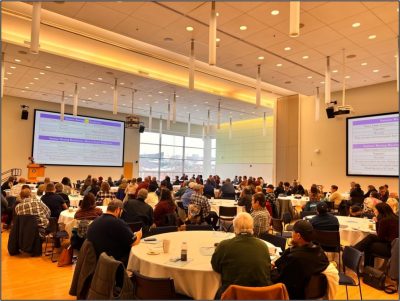
On-Farm Soil Steaming Demonstration
April 30, 2024, Fort Hill Farm, New Milford, CT
On April 30, 2024, the On-Farm Soil Steaming Demonstration was held at Fort Hill Farm in New Milford, CT, in collaboration with Connecticut Resource Conservation and Development (RC&D). The event was attended by 22 participants, primarily farmers, who were eager to learn about the potential of soil steaming for high tunnels and open fields.
Andre Cantelmo (Heron Pond Farm, NH) and Paul Buccigila (Fort Hill Farm, CT) shared insights on the practical applications of soil steaming. They highlighted its ability to control pathogens, weed seeds, nematodes, and other harmful organisms, ensuring healthier and more productive soil. A live demonstration showcased how steam is injected through perforated hoses under plastic sheets to sanitize the soil effectively.
Participants actively engaged in discussions on the costs, benefits, and operational logistics of adopting soil steaming. Feedback indicated a strong interest in its potential to reduce reliance on chemical fumigants while maintaining crop yields.
Farmers appreciated the hands-on nature of the demonstration and found the information practical and actionable. Many expressed interests in exploring this technique for their operations, especially in high-value crops or organic systems. The event also served as a platform for networking among farmers, researchers, and Extension specialists.
The demonstration successfully met its goals of raising awareness about soil steaming and providing farmers with actionable knowledge. Feedback from participants emphasized the relevance and practicality of the information provided, reinforcing the importance of such field-based learning opportunities.
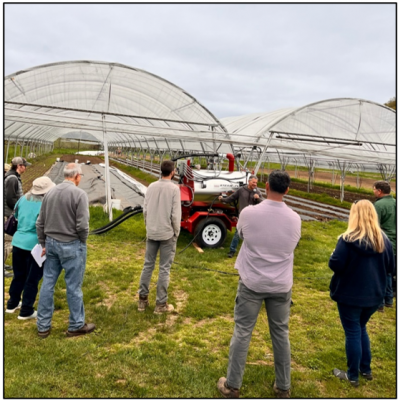
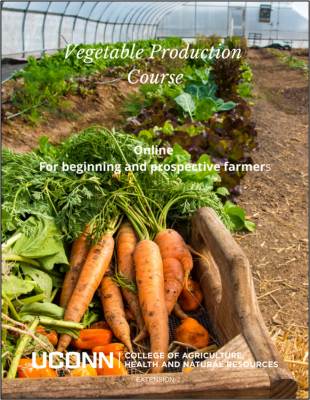
2024 UConn Extension Vegetable Production Certificate Course
Thirty-eight students enrolled in the UConn Extension online Vegetable Production Certificate course in the winter of 2024. The course had seven online modules, each module with a self-paced video, supplemental materials, and a short quiz. This course was designed to benefit beginner vegetable producers with 0-3 years of vegetable growing experience or no formal training in agriculture. The participants learned answers to the basic questions about farm business planning, planning and preparing for vegetable farm, warm and cool-season vegetable production techniques, season extension, identification of biotic and abiotic issues, and marketing. The students’ score on the knowledge test increased from an average of 64% before the course to 95% after the course.
Federally Recognized Tribes Extension Program (FRTEP) with Mashantucket Pequot Tribal Nation
The University of Connecticut Federally Recognized Tribes Extension Program (FRTEP) was launched in 2017 to address food insecurity, limited agricultural capacity, and significant health disparities within the Mashantucket Pequot Tribal Nation (MPTN). By 2024, the program supported the development of Meechoook farm featuring hydroponic greenhouses, shipping-container farming, and field production of vegetables and fruits. The farm produced diverse crops such as tomatoes, squash, cucumbers, strawberries, and broccoli, supporting food distribution to 15% of the Tribal population (approximately 180 members) and providing prescribed fresh produce to 30 diabetic patients since 2022. Extension educators emphasized IPM, delivering comprehensive training on pest identification, biological controls, and sustainable practices to reduce pesticide use and improve yields. These efforts continued into 2024, with ongoing workshops and training sessions to further embed IPM principles into the community’s farming practices.
Health and youth engagement were also critical aspects of the program. Nutrition workshops, virtual cooking sessions, and fitness classes fostered improved eating habits and health literacy. In 2022, 60% of youth participants enhanced their ability to identify active lifestyles, 50% improved knowledge of fruits and dairy, and 44% gained proficiency in selecting healthy snacks. The program’s success in integrating sustainable agriculture and health education led to the establishment of the MPTN Department of Agriculture, ensuring long-term sustainability. UConn FRTEP’s continued IPM training in 2024, combined with its holistic approach, significantly enhanced food sovereignty, economic resilience, and health outcomes, serving as a model for empowering Indigenous communities.
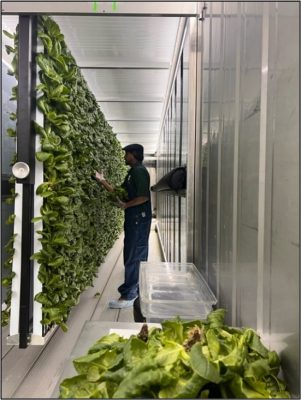
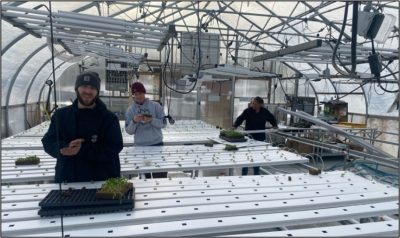
Weekly Pest Alert
Vegetable integrated pest management education was delivered to over 500 vegetable growers and stakeholders every week from April to October 2024 through 18 weekly vegetable pest alert emails focusing on pests, pest management and decision making, and safe pesticide use. The email open rate was 30%.
A winter squash plant devastated by hailstorm in August 2024 in Ceccarelli Harrison Hill Farm, Northford, CT Connecticut. As weather-related disasters are increasingly impacting farmers, more farmers have adopted climate-adaptation strategies to minimize the negative impact. Photo by Shuresh Ghimire.
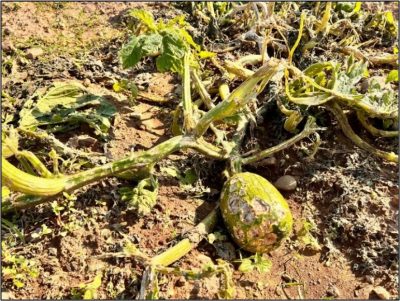
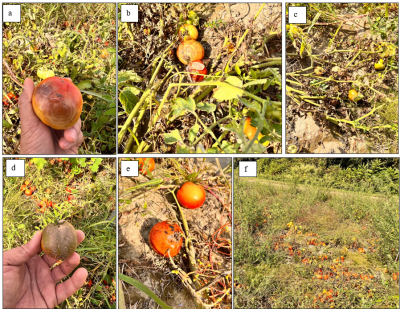
Tomato fruit infected with buckeye rot (a, b, c), physiological microcracks (d), and anthracnose (e). While the fruit load on the plants was good, the fruits were infected with several diseases and not marketable (f). Pictures taken on September 17, 2024, at Botticello Farms by Shuresh Ghimire.
Fruit Production and IPM
Program Leader: Even Lentz, Assistant Extension Educator
Operationalizing Drone Imaging Technology to Detect Nutrient Deficiencies in Fruit Orchards
This project is a continuation of our previous project “Drone Imagery for Early Detection of Fruit Crop Nutritional Deficiencies” funded through USDA SCBG via the CT Department of Agriculture. The first three-year project delivered 62 crop and nutrient specific predictive models. In this current three-year study, models are applied to inform foliar fertilizer applications in hopes of impacting the current year’s crop. This project includes seven grower participants: Belltown Hills Orchard, S. Glastonbury, Blue Hills Orchard, Wallingford, Roger Orchard, Southington, Joseph Preli Farm and Winery, S. Glastonbury, Scantic Valley Farm, Somers, Old Bishops Orchard, Cheshire, and the Mashantucket Pequot Tribal Nation, N. Stonington. The program has expanded participants to include new, woman, and BIPOC farmers. This is the first year that drone imaging technology has detected nutrient deficiencies. Therefore, corrective action recommendations were given to participating growers. Data from the collected fruit is being analyzed to determine if there is any improvement to production as a result of the drone technology. Due to site limitations, Scantic Valley and the Mashantucket Pequot Tribal Nation were not able to participate in 2024. Data collection will continue for the next year. Funding: Northeast SARE Research for Novel Approaches.
Solid Ground – New Farmer Training Sessions
Lentz served as one of the focus area consultants (Fruit Production and IPM) for the Solid Ground New Farmer Training program. Lentz organized and led five one-on-one on-farm consultations with new/beginning fruit farmers to assist in site evaluation, planning, varietal selection, and IPM program development. Funding: USDA NIFA CPPM.
One-on-one IPM Program Development
Lentz worked closely with four farms to develop their IPM programs: Joseph Preli Farm and Winery, S. Glastonbury, March Farms, Bethlehem, Cassidy Hill Vineyards, Coventry, and Hayward Orchards, New Hartford. This included regular trapping via the Fruit IPM Internship, NEWA Model integration, and pesticide application consultation. Funding: USDA NIFA CPPM.
Fruit IPM Messages
Fruit IPM e-updates are one of the most critical components of the UConn Fruit IPM program, according to growers. These messages provide pertinent information during critical periods throughout the growing season. In these updates, weather, phenology, management recommendations, local pest reporting (data gathered from across the state via the internship program), IPM strategies, programming updates, and event information are provided to growers in a direct, distilled manner. Updates are uploaded to the IPM website. Funding: USDA NIFA CPPM.
Undergraduate Fruit IPM Internship
In 2024, Lentz continued an undergraduate Extension internship focused on Commercial Fruit Production and Integrated Pest Management. Three students were employed for 15 weeks, for a total of 50 hours per week between them. The students learned and employed IPM scouting and trapping techniques at a total of 16 fruit farms in the state, including both small and tree fruit. The students visited farms weekly, reported findings to growers, compiled data to be shared with the fruit growing community, and worked to develop educational factsheets on related insect pests. The students attended multiple educational and industry meetings and gave a presentation at the Connecticut Pomological Society Summer Field Day. Funding: USDA NIFA CPPM.
Building Capacity
Lentz undertook efforts to build capacity within the UConn Fruit and UConn Fruit IPM programs. Building capacity has been undertaken in two major ways. First, Lentz has raised close to $20,000 from industry stakeholders and commercial fruit growers to establish a teaching and demonstration orchard within the bounds of the UConn Plant Science Research and Education Facilities in Storrs, CT. This highly diversified tree and small fruit orchard will serve the needs of the local fruit growing community for years and will serve as the site of pertinent Extension research and educational activities. Tile drainage has recently been installed across the entirety of the 6-acre site. Second, Lentz has developed relationships and applied for numerous grants with faculty members in the Nutritional Sciences department at UConn. Together, this team is looking to address IPM concerns of commercial fruit growers through fully integrated projects exploring organic indoor strawberry production and related issues such as the development of organic bio-fungicide and edible coatings to extend shelf-life post-harvest. Funding: USDA NIFA CPPM; Other
Events
Four major educational meetings were planned and implemented in collaboration with the Connecticut Pomological Society, UConn Extension, CT Farm Bureau, and other stakeholders: CT Farm Bureau Agricultural Expo (160 attendees), UConn Extension Vegetable and Fruit Growers Conference (211 attendees), CT Pomological Society Annual Summer Twilight Meeting and Field Day (150 attendees) and the CT Pomological Society Annual Winter Meeting (112 attendees).
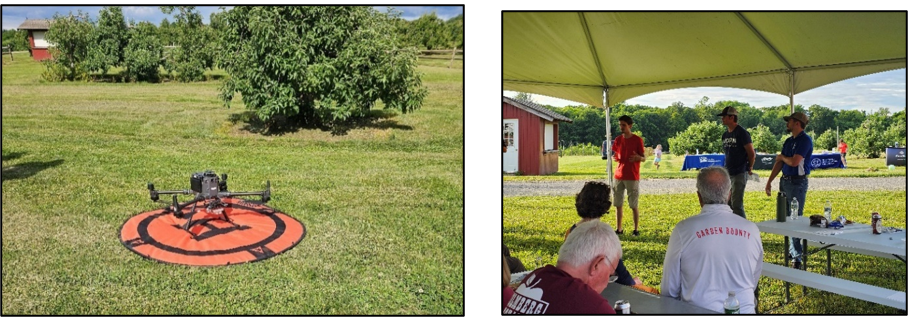
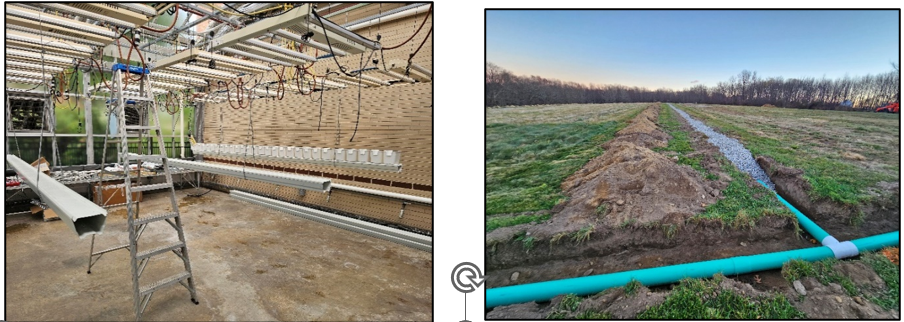
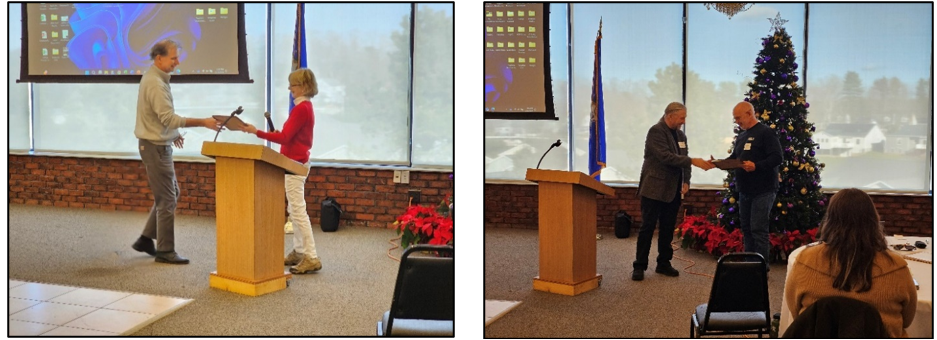
Other Programming
Lentz delivered a total of six presentations in 2024: Aroniaberry: A Native Superfood Pome Fruit – UConn Extension Vegetable and Fruit Growers Conference (211 attendees), Small Fruit Production for the Home Garden – Connecticut Nursery and Landscape Association (45 attendees), Organic Considerations for Small Fruit Producers – UMass transition to Organic Program (55 attendees), Small Fruit Production for the Home Garden – Quiet Corner Garden Club (54 attendees), San Jose Scale – Developing and IPM Plan – Connecticut Agricultural Expo (30 attendees), and Aroniaberry – A Native Superfood Pome Fruit: Production & Marketing – New England Vegetable and Fruit Conference (50 attendees).
Lentz served as the content area expert and instructor for the Tree and Small Fruit sessions of UConn Extension’s Master Gardener Program, delivering five separate day-long talks to stakeholders (212 attendees).
Lentz and the Northeast Extension Fruit Consortium developed and hosted a Winter Webinar Series for regional fruit growers with the following sessions:
- Cline, J. 2024. New thinning opportunities with ACC (Accede™) for apple and peach and Metramitron (Brevis) for apples. University of Guelph. (79 attendees);
- Amyotte, B. 2024. Strawberry Breeding and Cultivar Update. Agriculture and Agri-Food Canada. (39 attendees);
- Faruch and DeMarree. 2024. Use, efficacy and Cost of Reflective Ground Cover in Orchards. University of Maryland, DeMarree Fruit Farm. (25 attendees);
- Pinero, J. 2024. Mass Trapping for Japanese Beetle Management. University of Massachusetts. (41 attendees);
- McBride, J. 2024. How to Effectively Engage with the Press. University of Connecticut. (52 attendees);
- Cox and Kalnina. 2024. BioControl, Forecast Models and Apple Scab – Finding the Sweet Spot. Cornell University. (42 attendees).
In 2024, Lentz authored 4 articles for fruit producers in the CT IPM Crop Talk Newsletter: Blueberry Weed Control and Pre-Emergent Herbicides, Developing an IPM Plan for San Jose Scale, Spring Fungal Disease Outlook for Fruit Growers, and Spotlight: Unique Fruit Crops for Farm Diversification.
Greenhouse IPM
Program Leaders: Rosa Raudales (Associate Professor of Horticulture & Greenhouse Extension Specialist); Charles Krasnow (Associate Extension Educator, Controlled Environment Agriculture) Activities conducted by Leanne Pundt, Mayra Toro-Herrera, Rosa Raudales, and Charles Krasnow
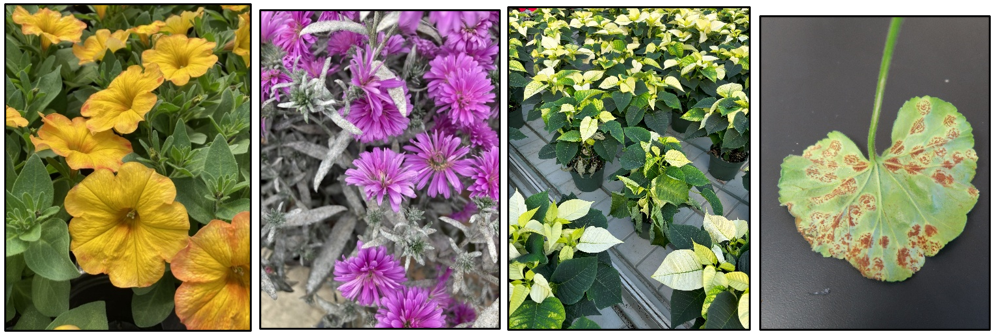
| # | Sponsored Education Program | Type of
event |
Focus | # of sessions | Attendees |
| 1 | Pundt, L. M Herrera-Toro, R.E. Raudales. Biological Control Conference for Ornamental Plants. New Haven, CT, August 15, 2024 | Workshop | In-state | 5 | 72 |
| 2 | Pundt, L. M Herrera-Toro, R.E. Raudales. Bedding Plant Meeting – Spring 2024! New Haven, CT. Jan 30, 2024 | Workshop | In-State | 3 | 32 |
| 3 | Ebba, J. R.E. Raudales. Northeast Greenhouse Conference Webinars. October 16 and Dec 11, 2024 | Webinars | Regional | 2 | 79 |
Bedding Plants Spring 2024
A half-day Bedding Plants program was held at the CT Agricultural Experiment Station in New Haven, CT on January 30, 2024. Presentation topics included: Plant Growth, Chemical and Cultural Options; Recap 2023; Bedding Crop Diseases to Prepare for in 2024, and Hot Topics in Insect and Mite Management. 34 attended from CT and MA. Of those that completed evaluation forms (25), 100% rated Hot Topics in Insect and Mite Management as very useful. 100% rated Plant Growth, Chemical and Cultural Options, and Bedding Plant Crop Diseases as useful to very useful. Of those that filled out evaluation forms, 87% were moderately to very likely to adopt a new practice.
Comments from participants:
“Very much appreciated the opportunity to reinforce my knowledge base.”
“Thank you for providing the information and resources.”
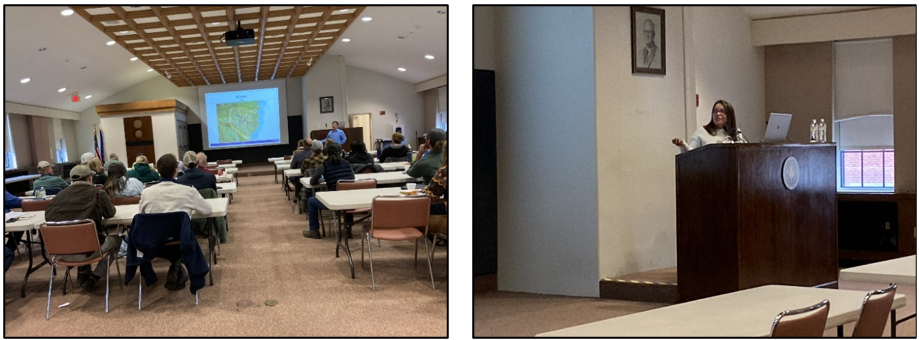
Biological Control Conference for Ornamentals
A full day Biological Control Conference was held at the CT Agricultural Experiment Station in New Haven, CT on August 15, 2024. Presentation topics were: Fungal Bioinsecticides as Tools to Manage Insect and Mite Pests of Greenhouse Crops; What’s the Latest in the World of Pest Management; Real World Use of Beneficials; Troubleshooting Your Biocontrol Program; Not all Thrips are Western Flower Thrips. 72 attended from CT, NY, MA, and PA. Of those that completed evaluation forms (65), 92% said that they would adopt a new practice.
Comments from participants:
- The speakers were incredibly informative.
- Thank you for all the new information to review.
- Great program! Great speakers and facility.
- Great mix of speakers. Awesome conference.
UConn Extension Welcomes New Extension Educator
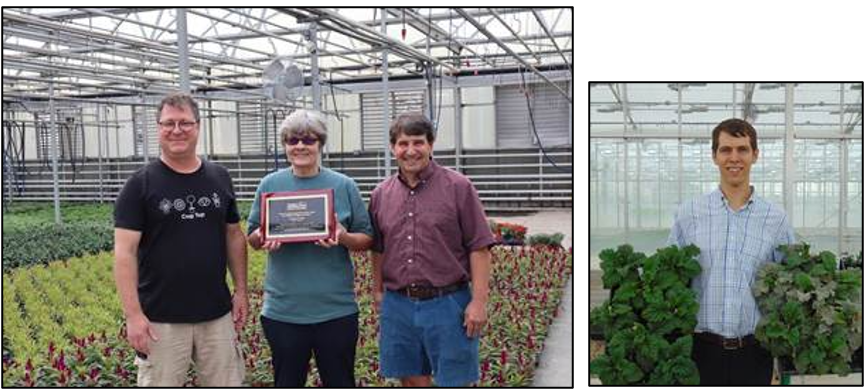
Extension Educator Leanne Pundt retired this year. Her dedication and support for greenhouse growers will be missed. Her legacy in biocontrol in the state is hard to measure. CT growers have a national reputation for their ability to successfully implement integrated pest management due to Leanne’s work and the industry’s trust in her recommendations.
The CT Greenhouse Growers’ Association gave her a plaque that read: “Connecticut Greenhouse Growers’ Association extends its profound gratitude and best wishes for a healthy and happy retirement to Leanne Pundt. Your 31-year collaboration with our industry and its member farms is true affirmation of your dedication and service. Your legacy will live on this industry’s innovations and sustainable practices in controlled environment agriculture.”
UConn welcomed Charles Krasnow as the new Associate Extension Educator in Controlled Environment Agriculture. Charles is a plant pathologist with experience in disease control of greenhouse ornamentals and vegetables. He has worked as a plant pathologist for Syngenta and in academia. Charles was mentored by Mary Hausbeck (Michigan State University) and Rob Wick (UMass Amherst).
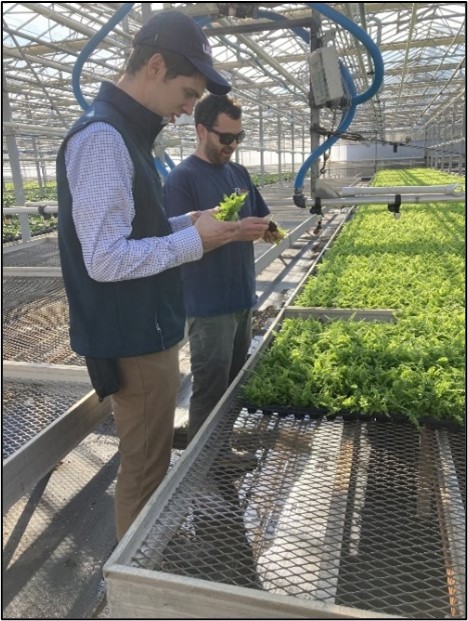
Professional Development
- Griffin Virtual Expo webinar, Making Biologicals Better, Easier and More Cost Effective, GS Pro, attended by L. Pundt. Sept 12, 2024.
- Hydroponics for Floriculture Production, AFE webinar, attended by L. Pundt. September 19, 2024.
- UMass Extension Crops and Floriculture Program. Get Ready for Spring Crops Part 2, attended by L. Pundt. March 5, 2024.
- ID and Management of Rot Diseases in Floriculture Crops. Francesca Hand, AFE webinar, attended by L. Pundt. May 21, 2024.
- Use of Drones in Cut Flower Production. AFE webinar attended by L. Pundt. June 18, 2024.
- Pennsylvania Invasive Species webinar: Invasive Thrips in Greenhouses. Webinar attended by L. Pundt. July 12, 2024.
- Trends to Watch in 2025. AFE Report Webinar. Attended by C. Krasnow. Nov. 19, 2024.
- AAS Display Gardens: “Best Practices” Educational Webinar. Attended by C. Krasnow. Dec. 4, 2024.
Consultations to Members of the Commercial Greenhouse Industry
47 grower visits by L. Pundt, 10 additional grower visits by L. Pundt with C. Krasnow, 25 grower visits by C. Krasnow, and 3 visits by R. Raudales and C. Krasnow, and 36 by the Raudales Lab, for a total of 121.
Weekly or biweekly pest messages were posted on the UConn Greenhouse IPM website ipm.cahnr.uconn.edu/greenhouse.
Comments from participants:
“Loved getting your emails because they were so helpful and often included some of the best conferences/seminars for pesticide credits and IPM information.”
Pollinator Program
Program Leader: Victoria Wallace, Extension Educator
Activities conducted by Victoria Wallace, Alyssa Siegel-Miles, and Sara Tomis
Supporting pollinator health is a high priority for the UConn Extension Sustainable Landscapes program. Declining pollinator populations are a great concern in all habitats, including those in managed landscapes. Green industry professionals can support pollinator health by incorporating more native plants in managed landscapes. Meadows are one viable option for expanding the use of native plants in managed landscapes.
Many municipalities and school grounds managers have expressed interest in developing meadow areas that can be used to provide biodiverse habitats for pollinators. A meadow on a school/municipal property is an opportunity to reduce inputs, particularly mowing. Many in the municipal sector have limited budgets, manpower, and tools; they cannot use EPA registered pesticides to aid in meadow establishment. It is critical that managers understand the challenges with establishing and maintaining a meadow.
A small meadow area was established at the UConn Plant Science Research Facility in 2022 to serve as a demonstration and educational resource that will help address questions related to meadow establishment and maintenance. In 2024, we maintained the meadow plots and compiled data related to the plant growth, including recording stem counts of each species present in both the spring-seeded and the fall-seeded plots to compare rates of establishment. We continue to evaluate meadow establishment practices, planting methods, and weed management strategies.
Victoria Wallace and Alyssa Siegel-Miles, Research Assistant, continue to produce Extension documents that benefit constituents and add them to the IPM website. The Native Tree, Shrub and Perennial Availability List, a partnership with CT DEEP Wildlife Division, was updated again this year, and included perennials for the first time. The Availability List is available online as a printable document to landowners, town planners, conservation groups, and landscape professionals who are interested in creating wildlife habitat using native plant material. This resource supports the marketing of ecologically beneficial CT specialty crop nursery producers to enhance their economic viability and connect consumers with native plants that are important to pollinator health and diversity, as well as cultivating resilient ecosystems. We will continue to work with the CT DEEP Wildlife Division to update this important resource and foster knowledge of CT native plant producers.
Comments from participants:
“This is an absolutely fabulous list you have made – both content and navigability. So glad you were able to add perennials, and to make note of cultivars vs. straight species.”
“The list is a fantastic resource for people; thank you all for putting it together.”
The program also released the UConn Pollinator Assessment Form (available in both online and PDF formats). The assessment is designed to help professional and home gardeners who are designing a landscape or evaluating the quality of an existing pollinator-friendly space. The assessment provides information to enable improvements and communicate the value of pollinator habitat in managed landscapes. The assessment can be used to collect baseline data and evaluate how populations and species diversity expand, improve or change over time.
Wesharednativeplantinformationandfactsheetswithover2000constituentsthroughourNativePlantemaillistserv, as well as reached over 1300 through our Invasive Plant email listserv and over 700 through our school IPM email listserv. Many others also receive the information via UConn Extension and other partners who share our information. We also translated several pollinator health factsheets into Spanish.
Pollinator health was included as part of online UConn ornamental & turf short course program held in winter (65 enrolled) and fall 2024 (60 enrolled).
Invasive Species IPM Program
Program Leader: Victoria Wallace, Extension Educator
Activities conducted by Victoria Wallace, Alyssa Siegel-Miles, Lauren Kurtz, and Sara Tomis
Invasive Plants: A Growing Concern
IPM methods can be used to manage invasive plants in residential properties, communities, and natural and managed landscapes. The UConn Invasive Species Outreach specialist, Lauren Kurtz, was hired in January 2024 and works under the Sustainable Landscapes Program. Invasive plant education has been conducted with CIPWG members during the growing season. The activities of the Connecticut Invasive Plants Outreach Specialist will provide administrative support for the Invasive Plants Council (IPC) and help to guide invasive plant education through public outreach, education, and training. Kurtz was an invited presenter at six events and highlighted the impact invasive plants are having on Connecticut ecosystems. She worked with CT DEEP to update the Aquatic Invasive Species portion of the CT DEEP website, particularly regarding the spread of Hydrilla in the CT River to other lakes and ponds throughout the state. Five media outlets including Hartford Courant, CT Insider, and Connecticut Public Radio have interviewed Lauren regarding the growing concern of invasive plants in the state. The invasive species program will continue to educate CT residents and businesses about their role in managing invasive plants.
An invasive plant certificate program is being developed by the Sustainable Landscapes Team to equip stakeholder groups of varied experiential backgrounds with the information needed to evaluate, manage, and mitigate populations of invasive species in Connecticut. This program will consist of eight asynchronous modules. The audience for this program includes land managers, conservation commission members, green industry professionals, municipal staff, advanced volunteers and homeowners interested in learning more about invasive plants and effective management strategies.
To develop this program, Wallace and her team completed a needs assessment through surveys and focus group interviews to better understand the needs of CT stakeholders. This assessment provided a clear understanding of knowledge gaps and how to gauge interest in an invasive species education program. Data was collected from 233 survey respondents and three focus group interviews with Master Gardeners, Nursery/Landscape Professionals, and invasive plant experts and volunteers. The greatest programmatic need identified by survey respondents was invasive plant management options and strategies, with Japanese knotweed considered the most problematic invasive plant from a list of 16 species. Focus group participants expressed enthusiasm about targeted educational programming, such as efforts focused on land management principles, species identification, state regulatory agencies, and pesticide application. Many shared the need for enhanced public education efforts and resource availability. A hybrid approach, including virtual and in-person components, was recommended as the ideal delivery modality for an invasive plant training program. A manuscript describing the needs assessment process has been published (Determining Need: Opportunities for Connecticut Invasive Plant Programming).
The Connecticut Invasive Plant Working Group (CIPWG) is a consortium of members of environmental organizations and affiliates of municipal and state agencies whose mission is to promote awareness of invasive plants and their non-invasive alternatives. CIPWG’s news and events listserv has over 1350 members. The CIPWG website (cipwg.uconn.edu) provides information on invasive plant identification and management, the Connecticut list of invasive plants, photos, native plant and other non-invasive alternatives, and legislative updates. Ms. Wallace serves as a co-chair and member of the steering committee and Symposium Planning Committee for CIPWG.
CIPWG exhibits were displayed, invasive plant talks were presented, invasive plant educational materials were provided, and/or invasive plant management activities occurred at local, statewide, and regional events during 2024. Activities occurred in over 60 CT towns. At least 6,053 citizens directly and actively participated in the activities. A minimum of 20,649 hours were directly invested in invasive plant management, during intensive invasive plant training sessions and management activities, as well as educational outreach. Many (at least 32,525) were reached indirectly through articles, YouTube videos, social media, fact sheets, signs, and other educational mediums. During the 2024 calendar year, there were 89,000 page views on the CIPWG website, and 47,000 users participated in 62,000 sessions. Users get to the site primarily (84%) through search results. The most visited pages are the Invasive Plant List (33K), the home page (9.2K) and the 2024 plant symposium page (3.7K). CIPWG started a new CIPWG Facebook page, led by UConn faculty and staff. As of December 2024, the page had 163 followers, 13,275 people have been reached, with 12,204 views since September 2024.
The twelfth biennial Connecticut Invasive Plant Working Group (CIPWG) symposium was held in Storrs, CT on October 29, 2024, with 390 people attending. The symposium theme was “Real Talk – Making an Impact in Invasive Plant Management.” The all-day event featured regional and local experts as well as citizen volunteers sharing practical solutions for invasive plant management and actions needed to promote native species and improve wildlife habitat.
The morning session included a keynote presentation by Peter Picone, CT DEEP: “For the Love of Plants…To Plant or Not to Plant? A Wildlife Biologist’s Perspective” and “CIPWG’s Role in Combatting Invasive Plants” by Victoria Wallace and Lauren Kurtz, UConn, and Bryan Connolly, ECSU. There were six breakout sessions that were held in the afternoon.
Out of 171 evaluation respondents, 95% of attendees rated the symposium as “good” or “very good.” 91% of evaluation respondents agreed that information presented during the keynote talk will help them improve their invasive plant management skills and tactics. Symposium 2024 handouts, powerpoints, and information are available on the CIPWG website.
Comments from participants:
“I got so much out of Tuesday’s conference, and feel energized to move forward with new ideas, thanks to the experiences shared by speakers.”
“I found it most valuable as an amazing networking opportunity. The Les Mehrhoff award winner was completely inspiring! Thank you for all your hard work. What a feat! Already looking forward to the next one in 2026!”
“Such great options for courses, offering similar courses at every conference is so helpful for a first timer trying to catch all that info! The afternoon “common questions” panel was phenomenal!”
“Truly enjoyed this event. It was very well structured!”
“I liked seeing the sample invasive plant specimens in one of the rooms, to help with their identification.”
Victoria Wallace also served as the UConn CAHNR Dean Representative and Chair of the Invasive Plants Council (IPC), a state-legislated committee mandated by the CT Legislative Environment Committee, for the 2024 term. In response to recommendations made in the 2023 IPC annual report, the Environment Committee in 2024 submitted HB 5225 to include five additional plants on the CT Invasive Plant List and two additional to be prohibited from sale. Following testimony in support of the bill from IPC members, CT Invasive Plant Working Group (CIPWG) members, other green industry associations stakeholders, and CT residents, the bill was passed, and the CT Invasive Plant List was amended for the first time in many years.
The IPC has maintained momentum following passage of the bill. The council considered recommendations from CIPWG regarding the status of Japanese barberry and Burning bush, two invasive plants not prohibited from sale. The IPC will bring the recommendations to the CT Legislative Environment Committee and encourage the Environment Committee to take immediate action to approve and adopt the IPC recommendations.
Invasive Biological Control Projects: Swallowwort
Victoria Wallace served as the Principal Investigator for a USDA APHIS biological control project of swallow-wort, a serious invasive weed of meadows, pastures, roadsides, woodland edges and coastal shorelines. Ms. Wallace supervised the efforts of a research technician who evaluated seasonal feeding damage of the biological control agent (Hypena opulenta) after its release onto dense monocultures of swallow-wort. The grant ended in May 2024. A fact sheet and an infographic for swallow-wort biological control are available on the IPM website. The introduction and establishment of biological control agents to reduce populations of swallowwort in CT provide a sustainable method of managing this invasive pest in open spaces throughout Connecticut.
School IPM Program
Program Leader: Victoria Wallace, Extension Educator
The Connecticut School IPM Program was formed to support and provide in-person educational programs for School and Municipal Grounds Managers with turf care and landscape practices following the statewide ban of pesticides on daycare and K-8 school properties. Assessment tools and recommendations for school grounds and athletic fields that support management practices have been developed.
The UConn Turfgrass Field Day was held on July 25, 2024 and served as the annual educational program for school and municipal grounds managers as well as other turfgrass professionals. The program was attended by 265 people, including municipal and grounds managers. The program included research tour stops hosted by UConn turfgrass researchers who share explanations and fielded questions about their current projects, which is designed to address real-world problems turfgrass professionals face daily, as well as find solutions to make turfgrass more sustainable by reducing the amount of water, fertilizer, and pesticides managers need to use. Of the 49 attendees who completed the evaluation, 95% agreed that they have a deeper understanding of ways to make their turfgrass management practices more sustainable due to attending the Field Day. 91% agreed that they would be willing to implement more sustainable approaches to turfgrass management because of Field Day. An article in UConn Today detailed the event.
Comments from participants:
“Awesome event! Do this every year.”
“Great day, Thank you. It was very useful and interesting.”
“Everything you guys have done is great.”
“Keep up the great work.”
Additionally:
- In winter 2024, Wallace assumed the teaching responsibility for the Turf Management section of the Master Gardener Curriculum; created three modules for the turfgrass section and presented five corresponding live in-person classes on pollinator-friendly turfgrass management. Presentation showcases differences and similarities between various sustainable turfgrass management options and viable turfgrass management systems.
- The athletic field assessment app is nearly completed. The app is being field tested to improve the user experience and identify any needed corrections before finalization and release.
- Weather stations previously placed at Connecticut schools and used to assist with critical IPM decision-making on athletic fields and school grounds management has continued.
- Victoria Wallace provided one-on-one consultation and support for Landscape Professionals. 40 one-on-one consultations were completed via phone, text, and email. Wallace provided Sustainable Landscape expertise, including pollinator health via periodic email and phone consultations.
Sustainable Landscapes Program
Program Leader: Victoria Wallace, Extension Educator
To support turfgrass selection efforts of school grounds managers and landscape professionals, Wallace collaborates with the National Turfgrass Evaluation Program (NTEP) and evaluates turfgrass genotypes intended for the commercial seed market. Wallace is also the UConn cooperator for the Alliance of Low Input Sustainable Turf (A-List), a program that evaluates turfgrass species maintained with a regime of minimal input. Her previous experience as an agronomist in the turfgrass seed industry enables the effective connection of the value of these turfgrass evaluation programs to program stakeholders. Both programs are nationally recognized and valuable to the program stakeholders, who practice IPM and manage turfgrasses with reduced inputs of fertilizers, water, or pesticides. These turfgrass varieties are showcased at our biennial Turfgrass Field Day, which is attended by turfgrass professionals, seed company representatives, and product suppliers from throughout the northeast.
Ongoing evaluation of turfgrass cultivars under low maintenance regimes was conducted. UConn is a cooperator evaluation site for the National Turfgrass Evaluation Program (NTEP) and the Alliance for Low Input Sustainable Turfgrass (A-LIST). Selection of sustainable turfgrass varieties is important for all turfgrass professionals, including turfgrass managers who must manage non-irrigated, pesticide free school athletic fields with a limited budget and few resources. Use of turfgrass seed mixtures that include improved cultivars that perform well with fewer inputs is an important management strategy for school and municipal grounds managers.
National Turfgrass Evaluation Program
Fineleaf Fescue Test
Year 4 data was collected for a 5-year evaluation test of fine fescue cultivars. UConn serves as an evaluation
location for this national turfgrass test.
Perennial Ryegrass
Year 2 data was collected for a 5-year evaluation test of perennial ryegrass cultivars. UConn serves as an evaluation location for this national turfgrass test.
Kentucky Bluegrass
A new Kentucky bluegrass trial was seeded in September 2024.
Tall Fescue
A new tall fescue trial was seeded in August 2024.
Alliance for Low Input Sustainable Turfgrass (ALIST) Evaluation
Perennial Ryegrass
Year 1 data was collected for the two-year evaluation test of perennial ryegrass cultivars.
Conference Programs
Presentations were conducted virtually and in person (nationally, regionally and in state). Victoria Wallace was a presenter at the New England Regional Turfgrass Foundation (NERTF) conference, Connecticut Environmental Council (CTEC), Vermont Greenscape Conference, Atlantic Golf and Turf Educational Workshop, and for the New England Sports Field Managers Association webinar series. Presentation topics included integrating environmentally sound best practices in athletic field maintenance programs, turfgrass selection and establishment considerations impacted by weather, and turfgrass management strategies related to pollinator health.
Cornell “Short Cutts”
V. Wallace serves as UConn representative for a regional turfgrass conference call and newsletter (33-35 weeks/year; April-October), hosted by Cornell Extension faculty. IPM recommendations for turfgrass managers along with current research and weather forecasting were made available to Extension faculty in the Northeast.
Pesticide Safety Education
Program Leader: Srikanth Kodati, Assistant Extension Educator
Ornamental and Turf Short Course
The Ornamental and Turf Short Course helps in the preparation for the CT’s category 3A supervisory licensing exam. The course provides an in-depth online educational program that reviews the information necessary to fulfill the requirements of the Ornamental and Turf/Golf Course Superintendents State of Connecticut Supervisory Pesticide Applicator Certification exam. There are eight modules for this educational program. Class topics are: Pesticide Laws, Regulations and Safety; Botany; IPM Principles; Plant Pathology and Ornamental Plant Diseases; Entomology and Insect Pests of Woody Ornamentals; Area and Dosage Calculations; Turfgrass Management; and Weed Management. Each class begins with a brief overview of the topic, then continues with an in-depth discussion of pests, their biology and control. In 2024, the online winter session ran from January-March (65 attendees), and a fall session ran from October-early December (60 attendees). Eighty percent of attendees attended the classes every week. In Fall 2024, a new module on tick management was added, which is one of the important areas for supervisory licensing exam. Instructors included: Sarah Bailey, Nick Goltz, Srikanth Kodati, Victoria Wallace, and Robert Durgy (CT Agricultural Experiment Station).
Kodati also taught the pesticide safety course in Spring and Fall of 2024 as one of the modules for the Arboriculture 101 course offered by the Connecticut Tree Protective Association, which helps students prepare for the Arborist certification. There was a total of 105 students in the class; all rated this module as very informative.
Programs:
- CT Nursery and Landscape Association Winter Symposium. Pesticide Safety 101: How to Read the Pesticide Label. Plantsville, CT. January 24, 2024, 20 in attendance.
- Annual Tobacco Research Meeting. Pesticide Safety for Pesticide Applicators. Somers, CT. March 6, 2024. 60 in attendance.
- Participated in Ag. Day at the Capitol on March 20th, 2024. Promoted the importance of pesticide safety education and UConn IPM teams’ work as part of UConn Extension. Hartford, CT. 30 contacts.
- Vegetable IPM Workshop. Pesticide Safety Program Updates. August 1, 2024. 21 people in attendance.
- IPM Seminar for Home Gardeners. How to Read a Pesticide Label and Pesticide Calculations. Storrs, CT. August 3, 2024. 25 people in attendance.
- The CT Ag Expo. Drones in Pesticide Applications – Opportunities and Challenges. Southington, CT. November 20, 2024. 25 people in attendance.
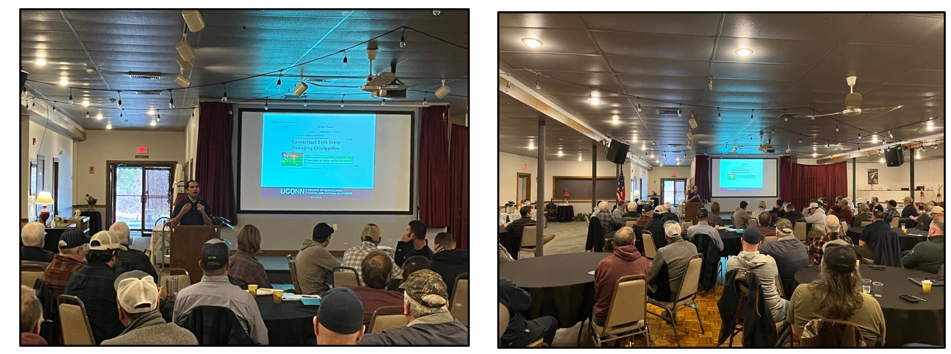
Diagnostics
Program Leader: Dr. Nick Goltz, DPM, Assistant Extension Educator
Between January 1 and December 16, 2024, the UConn Plant Diagnostic Laboratory (PDL) processed a total of 275 physical samples. Compared to 265 physical samples received last year (2023), this was an increase of approximately 4%. Additionally, the lab directly responded to at least 300 stakeholder plant health inquires via phone, email, and walk-in. The lab also directly supported the efforts of the UConn Home & Garden Education Center (HGEC), which responded to more than 1,684 additional stakeholder inquiries in 2024. At least 231 towns in Connecticut and neighboring states were represented in these numbers.
Plant samples were accepted from both homeowner and commercial clients from all eight Connecticut counties, as well from several counties in Massachusetts, Rhode Island, and New York (Table 1). Sample types submitted this year included agronomic field crops, landscape ornamentals, ornamentals from nurseries and greenhouses, plants grown for the purpose of conducting research, and specialty fruit, ornamental, and vegetable crops. Diagnostic services rendered included plant disease diagnoses, abiotic disorder diagnoses, plant identification, and insect identification. More than 1,187 diagnostic procedures were performed to determine the provided diagnoses. A cost-recovery sample processing fee of $20.00 per sample for 92 samples from Connecticut commercial growers (of 100 budgeted) was covered by a USDA NIFA CPPM grant.
As of Dec. 1st, 2024, Goltz wrote two blog posts and two articles for newspapers or online news sites that covered plant health and IPM topics. He contributed to the 2025-2026 edition of the New England Vegetable Management Guide (in press), covering diseases of Globe Artichoke, Leek, Lettuce/Endive/Escarole, Okra, Onion/Scallion/Shallot, Parsley and Cilantro.
Goltz presented two modules for the pesticide applicator certification course, five plant pathology classes for the UConn Master Gardener program, and presented as a guest lecturer five times for courses not taught by him at UConn. He co-taught SAPL 810 and SAPL810L: Plant Pest Control and Plant Pest Control Lab with Co-PI Lentz, in which he covered IPM strategies for the management of weeds, plant diseases, and insects of agronomic importance.
Goltz gave presentations for the 2024 Connecticut Flower and Garden Show, “Flower Diseases 101,” The UConn Grow Your Own Way program, “Common Garden Pests and Diseases,” and the 2024 UConn Vegetable IPM Field Workshop, “2024 Plant Disease Update: Common Bacterial Diseases of Vegetables.” He was an invited speaker for the 7th National Plant Diagnostic Network National Meeting in Portland, Maine, where he participated in a panel titled, “Feeding the Professional Pipeline: Building Future Diagnosticians in a Changing World.” He was invited to co-organize and deliver a workshop, “Bacterial Basics” for registered participants. He also co-created and presented two posters, “NPDN Proficiency Committee: Essential Proficiency Program Release,” and “The NPDN Professional Development Program: 5 Years In, Where Are We Now?” Goltz also organized the Third Annual IPM Seminar for Home Gardeners event and presented a talk titled, “2024 Disease Update and Plant Health Tips.”
The UConn Plant Diagnostic Lab is part of the National Plant Diagnostic Network, an internationally recognized consortium of plant diagnostic laboratories funded in part by the USDA National Institute of Food and Agriculture and the US Department of Homeland Security.
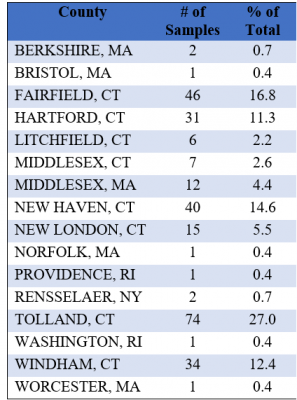
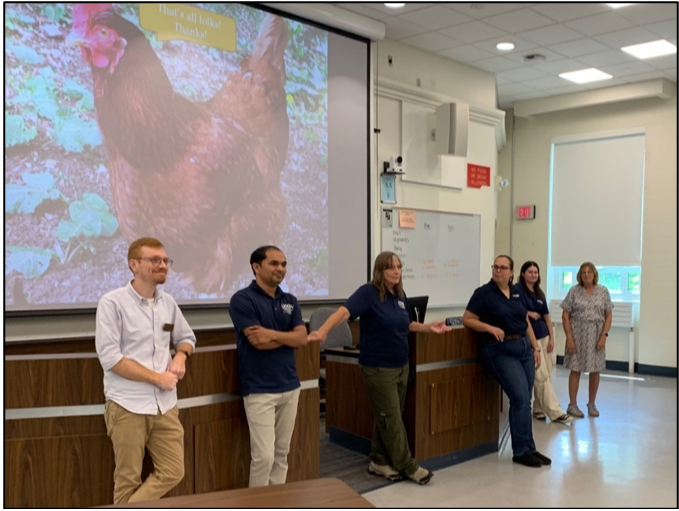
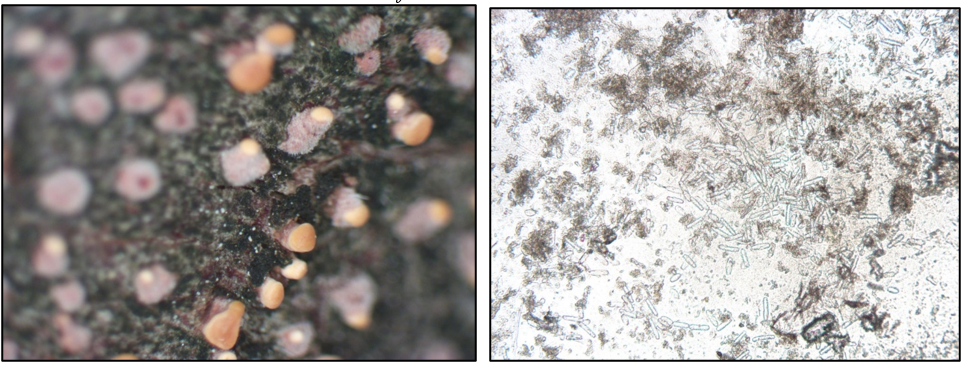
Urban Agriculture
Program Leader: Jacqueline Kowalski, Associate Extension Educator
Urban agriculture IPM is a new component to the University of Connecticut IPM team.
Trapping Network
In 2024, the Urban Agriculture IPM program participated in the Great Lakes Urban Agriculture IPM Workgroup trapping network for Squash Vine Borer (SVB). Participation in this network extended from South Dakota to Connecticut to test a new trap design to develop better management strategies for SVB for urban farmers.
Urban Farmer Training Program
The Urban Farmer Training Program (UFTP) was offered in collaboration with Green Village Initiative, Bridgeport, CT. The purpose of this program is to provide intensive training for those who want to become for-profit urban farmers. Three students graduated from the program this season. The training site provided the opportunity for IPM training for both the participants and the community gardeners who grow at Reservoir Farm, Bridgeport, Connecticut.
Solid Ground Consultations
Kowalski served as a consultant for the urban agriculture focus area for the UConn Solid Ground program. Kowalski provided four one-on-one on-farm consultations with new/beginning urban farmers to assist in site evaluation, soil health, production planning, varietal selection, and IPM program development.
Vegetable Entomology
Program Leader: Dr. Ana Legrand, Assistant Extension Professor
Potato Leafhopper Monitoring & Remote Sensing Project
A multi-disciplinary team at the University of Connecticut continued to develop a monitoring system for insect pest damage using drones outfitted with spectral sensors. The goal is to detect the presence and early plant damage caused by the potato leafhopper (PLH) on green beans. PLH is a significant pest in several horticultural systems. This work has the potential to benefit multiple commodities through early detection of the insect with minimal labor inputs by growers. PhD student Bivek Bhusal worked on greenhouse and field experiments to advance this project. In 2024, the project continued the evaluation of abiotic factors like nitrogen fertilization that could confound remote sensing signals from PLH feeding damage. Results indicate that it is possible to detect PLH damage separate from nitrogen deficiency stress using drones to capture spectral images from the field. Mr. Bhusal shared project results by presenting the Entomological Society of America Annual Meeting.
Brassica Trap Crops Project
Efforts to develop a ‘push-pull system’ for diamondback moth management in cabbage continued. Trap crops attract the pest away from the main crop, thus concentrating pest infestations in a smaller area that can be treated or destroyed. Project results indicated the strong potential of glossy collards as trap crops when planted together with tomatoes as the repellent crop to create the ‘push-pull’ system. Repellent plants act as the ‘push’ factor and complement the trap crops providing the ‘pull’ effect to reduce pest pressure on the cash crop. Maussi Arrunategui, PhD student in Dr. Legrand’s lab, continues to work on this project.
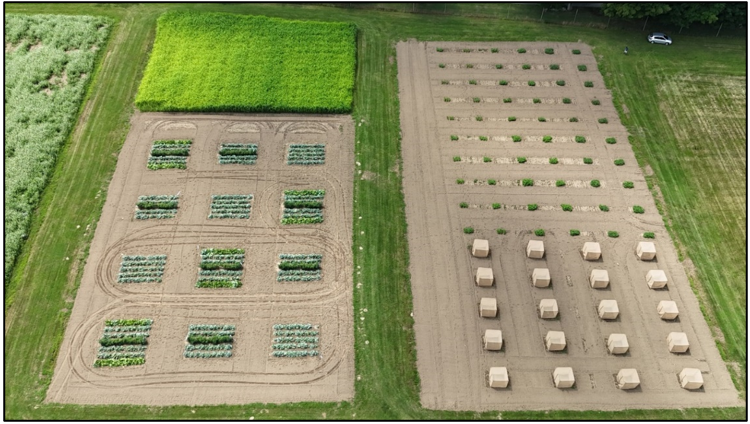
Vegetable Entomology Outreach
Dr. Legrand gave several presentations on vegetable insect pest management and co-organized the 2024 Vegetable IPM Field Workshop with Dr. Shuresh Ghimire. The workshop was conducted at the Plant Science Research and Teaching Facility in Storrs, CT, with 25 attendees. The workshop covered diverse topics of importance to vegetable growers, including plant disease management, insect pests, and climate adaptation tools. 21 attendees who completed the evaluation rated their overall before- and after-program knowledge change (1-5 rating scale with 5 being most knowledge) as 2.25 to 4.25. On the topic of brassica caterpillar scouting, attendees rated their knowledge change from 2 to 5. Dr. Legrand also participated in the planning committee for the 2025 UConn Extension CT Vegetable and Fruit Growers Conference.
Comment from 2024 Vegetable IPM Field Workshop participant:
“Great program. Learned a lot. Thank you!”

2024 IPM Projects and Publications
Refereed Journal Articles
Grandstaff, G., J. Kuzovkina and A. Legrand. 2023. Attraction of bees to native and introduced willows (Salix spp.). Forests, 15(4):3639. https://doi.org/10.3390/su15043639
Cabrera-Garcia, J., M.A. Toro-Herrera, and R.E. Raudales. 2024. Assessing micro-irrigation clogging risk through water quality classification systems. Water Practice and Technology, 19(8): 3237–3250. https://doi.org/10.2166/wpt.2024.199
Toro-Herrera, M. and R.E. Raudales. 2024. The Application Timing of a Cytokinin/Boron-based Product Affects Root Growth and Non-Structural Carbohydrates of Coleus (Plectranthus scutellarioides cv Wild Lime) during Adventitious Root Formation. HortScience, 59(6):840-848. https://doi.org/10.21273/HORTSCI17756-24
Raudales, R.E., M. Toro-Herrera, P. Fisher, J. Boldt, and J. Altland. 2024. Paclobutrazol Residues in Recirculated Water in Commercial Greenhouses. HortTechnology, 34(2):198-203 https://doi.org/10.21273/HORTTECH05367-23
McGehee, C.S., A. Louyakis, and R.E. Raudales. 2024. Spatial variation of oomycetes and bacteria on surfaces, solutions, and plants from a commercial hydroponic greenhouse. Phytobiomes Journal. 8(3):297-308: https://doi.org/10.1094/PBIOMES-08-23-0078-R
Tomis, S. M., L. E. Kurtz, A. J. Siegel-Miles, and V. Wallace. 2024. Determining Need: Opportunities for Connecticut Invasive Plant Programming. HortTechnology, 34(4):485–492. https://doi.org/10.21273/HORTTECH05467-24
Factsheets and Publications
Ghimire, S. 2024. Soil fertility management for vegetable farms. UConn Extension Factsheet #EXT062. https://doi.org/10.61899/ucext.v1.062.2024
Scherbatyuk, N., S. Ghimire, B. Weiss, A. Williams and L.W. DeVetter. 2024. Impact of mulching on specialty crops performance. Washington State University Factsheet. 6 pp. https://smallfruits.wsu.edu/documents/2024/06/fact-sheet-impact-of-mulching-on-specialty-crop-performance.pdf/
Goltz, N.C. 2024. Diseases of Globe Artichoke, Leek, Lettuce/Endive/Escarole, Okra, Onion/Scallion/Shallot, Parsley and Cilantro in 2025-2026 New England Vegetable Management Guide (in press). 19 pp. https://nevegetable.org.
Pundt, L. 2024. Vegetable Transplant Production in New England Vegetable Management Guide. 21 pp. https://nevegetable.org/vegetable-transplant-production
Pundt, L. 2024. Echinothrips americanus. UConn IPM factsheet. 3 pp. https://ipm-cahnr.media.uconn.edu/wp-content/uploads/sites/3216/2024/06/echinothripsamericanus-3.pdf
Pundt, L. 2024. Managing Thrips on Vegetable Transplants. UConn IPM factsheet. 3 pp. https://ipm-cahnr.media.uconn.edu/wp-content/uploads/sites/3216/2024/05/thripsvegtransplants-4.pdf
Pundt, L. 2024. Downy Mildew on Basil in the Greenhouse. UConn Extension Factsheet #EXT034. https://doi.org/10.61899/ucext.v1.035.2024
Pundt, L. 2024. Non-Infectious Plant Disorders: Oedema and Intumescences. UConn Extension Factsheet #EXT036. https://doi.org/10.61899/ucext.v1.036.2024
Pundt, L. 2024. Managing Fungus Gnats and Shore Flies in Commercial Greenhouse Vegetable Transplant Production. UConn Extension Factsheet #EXT060. https://doi.org/10.61899/ucext.v1.060.2024
Picone, V. Wallace, A. Siegel-Miles, and S. Tomis. 2024. Native Tree, Shrub, and Perennial Availability List. 19 pp. ipm.cahnr.uconn.edu
Wallace, V., A. Siegel-Miles, and S. Tomis. 2024. UConn Pollinator Assessment Form. Univ. of Connecticut, Storrs, CT. 4 pp. ipm.cahnr.uconn.edu/pollinators
Kurtz, L., A. Siegel-Miles, and V. Wallace. 2024. Invasive Species Profile: Hydrilla verticillata. Univ. of
Connecticut, Storrs, CT. 4 pp. https://doi.org/10.61899/ucext.v1.061.2024
Kurtz, L., A. Siegel-Miles, and V. Wallace. 2024. Invasive Plant Triage. Univ. of Connecticut, Storrs, CT. 4 pp.
Newsletters and Articles
Ghimire, S. and J. Kowalski. 2024. Can Biochar be a Sustainable Soil Amendment for Connecticut Farms? UConn Extension and Department of Plant Science and Landscape Architecture Crop Talk Newsletter, 21(2):6-7. https://ipm-cahnr.media.uconn.edu/wp-content/uploads/sites/3216/2024/05/Crop-Talk-May-2024.pdf
Ng, M. and S. Ghimire. 2024. Soil Steaming for Pest Management. UConn Extension and Department of Plant Science and Landscape Architecture Crop Talk Newsletter, 21(2):13-17. https://ipm-cahnr.media.uconn.edu/wp-content/uploads/sites/3216/2024/05/Crop-Talk-May-2024.pdf
Ghimire, S. 2024. Guidelines for Soil Fertility Management on Vegetable Farms. UConn Extension and Department of Plant Science and Landscape Architecture Crop Talk Newsletter, 21(1):7-9. https://ipm-cahnr.media.uconn.edu/wp-content/uploads/sites/3216/2024/03/Crop-Talk-March-2024.pdf
Goltz, N.C. 2024. Bulb Diseases. University of Connecticut Ladybug Blog. https://uconnladybug.wordpress.com
Goltz, N.C. 2024. Be Prepared for Ticks. University of Connecticut Ladybug Blog. https://uconnladybug.wordpress.com
Goltz, N.C. 2024. Is Early Leaf Drop an Indicator of Tree Health?. The Chronicle.
Legrand, A. 2024. Bacterial plant pathogens and their overwintering ‘bug’ refuges. UConn Extension and Department of Plant Science and Landscape Architecture Crop Talk Newsletter, 20(1):19-21. https://ipm-cahnr.media.uconn.edu/wp-content/uploads/sites/3216/2024/03/Crop-Talk-March-2024.pdf
Lentz, E. 2024. Blueberry Weed Control and Pre-Emergent Herbicides. UConn Extension and Department of Plant Science and Landscape Architecture Crop Talk Newsletter, 20:4. https://ipm-cahnr.media.uconn.edu/wp-content/uploads/sites/3216/2024/11/Crop-Talk-November-2024_r.pdf
Lentz, E. 2024. Developing an IPM Plan for San Jose Scale. UConn Extension and Department of Plant Science and Landscape Architecture Crop Talk Newsletter, 20:3. https://ipm-cahnr.media.uconn.edu/wp-content/uploads/sites/3216/2024/10/Crop-Talk-October-2024.pdf
Lentz, E. 2024. Spring Fungal Disease Outlook for Fruit Growers. UConn Extension and Department of Plant Science and Landscape Architecture Crop Talk Newsletter, 20:2. https://ipm-cahnr.media.uconn.edu/wp-content/uploads/sites/3216/2024/05/Crop-Talk-May-2024.pdf
Lentz, E. 2024. Spotlight: Unique Fruit Crops for Farm Diversification. UConn Extension and Department of Plant Science and Landscape Architecture Crop Talk Newsletter, 20:1. https://ipm-cahnr.media.uconn.edu/wp-content/uploads/sites/3216/2024/03/Crop-Talk-March-2024.pdf
Lentz, E. 2024. Fruit Updates. (30 messages). https://fruit.cahnr.uconn.edu/
Pundt, L. 2024. Managing Fungus Gnats and Shore flies in Vegetable Transplant Production. UConn Extension and Department of Plant Science and Landscape Architecture Crop Talk Newsletter, 21(1):3-6. https://ipm-cahnr.media.uconn.edu/wp-content/uploads/sites/3216/2024/03/Crop-Talk-March-2024.pdf
Pundt, L. 2024. Managing Aphids in Vegetable Transplants. UConn Extension and Department of Plant Science and Landscape Architecture Crop Talk Newsletter, 21(2):2-6. https://ipm-cahnr.media.uconn.edu/wp-content/uploads/sites/3216/2024/05/Crop-Talk-May-2024.pdf
Raudales, R.E. 2024. Sanitation: A culture to be established & nurtured. E-Gro 13(8). https://www.e-gro.org/pdf/2024-13-08.pdf
Toro-Herrera M.A., R.E. Raudales. 2024. “Sugar Translocators”— a fad diet or a true program for rooting? E-Gro 13(53). https://e-gro.org/pdf/2024-13-53.pdf
Pundt, L. 2024. Start the New Year by Earning Pesticide Credits. January 5, 2024.
Pundt, L. 2024. Spring Start Up. Proper Sanitation, Starting Seedlings, Aphids. January 12, 2024. https://ipm-cahnr.media.uconn.edu/wp-content/uploads/sites/3216/2024/01/2024greenhousepestmessageJanuary12.pdf
Pundt, L. 2024. Alarming Aphids, Spider Mites, Fungus Gnats. February 9, 2024. https://ipm-cahnr.media.uconn.edu/wp-content/uploads/sites/3216/2024/02/2024greenhouse-pestmessagefeb9.pdf
Pundt, L. 2024. Transplanting Plugs, Preventing Algae in Vegetable Transplants. February 16, 2024. https://ipm-cahnr.media.uconn.edu/wp-content/uploads/sites/3216/2024/02/2024greenhousepestmessagefeb16final.pdf
Pundt, L. 2024. Lacewing larvae, Guide to Biological Control Agents from MSU State. February 22, 2024. https://ipm-cahnr.media.uconn.edu/wp-content/uploads/sites/3216/2024/02/2024greenhousepestmessagefeb16final.pdf
Pundt, L. 2024. Preventing Aphids especially on million belles, Broad Mites. March 1, 2024. https://ipm-cahnr.media.uconn.edu/wp-content/uploads/sites/3216/2024/03/2024greenhousepestmessageMarch4-1.pdf
Pundt, L. 2024. Preventing Botrytis Blight. March 5, 2024. https://ipm-cahnr.media.uconn.edu/wp-content/uploads/sites/3216/2024/03/2024greenhousepestmessageMarch5.pdf
Pundt, L. 2024. Aphids, thrips. March 22, 2024. https://ipm-cahnr.media.uconn.edu/wp-content/uploads/sites/3216/2024/03/2024greenhousepestmessageMarch22nd.pdf
Pundt, L. 2024. Fungus gnats, powdery mildew on vegetative petunia. March 29, 2024. https://ipm-cahnr.media.uconn.edu/wp-content/uploads/sites/3216/2024/04/2024GreenhousepestmessageMarch29.pdf
Pundt, L. 2024. Aphids, botrytis blight and spider mites. April 5, 2024. https://ipm-cahnr.media.uconn.edu/wp-content/uploads/sites/3216/2024/04/2024greenhousepestmessageapril5.pdf
Pundt, L. 2024. Downy mildew. April 11, 2024. https://ipm-cahnr.media.uconn.edu/wp-content/uploads/sites/3216/2024/04/2024greenhousepestmessageapril11.pdf
Pundt, L. 2024. Aphids, oedema, continue fertilizing crops. April 19, 2024 https://ipm-cahnr.media.uconn.edu/wp-content/uploads/sites/3216/2024/05/2024greenhousepestmessageApril19.pdf
Pundt, L. 2024. Hover fly larvae. April 26, 2024 https://ipm-cahnr.media.uconn.edu/wp-content/uploads/sites/3216/2024/05/2024greenhousepestmessageApril26.pdf
Pundt, L. Thrips parvispinus online resources. May 16, 2024. https://ipm-cahnr.media.uconn.edu/wp-content/uploads/sites/3216/2024/05/2024greenhousepestmessagemay16.pdf
Pundt, L. 2024. Fertilizing Plants in Retail Settings. May 23, 2024. https://ipm-cahnr.media.uconn.edu/wp-content/uploads/sites/3216/2024/05/2024greenhousepestmessagemay23.pdf
Pundt, L. 2024. Early season care of garden mums. June 6, 2024. https://ipm-cahnr.media.uconn.edu/wp-content/uploads/sites/3216/2024/06/2024greenhousepestmessageJune6.pdf
Pundt, L. 2024. Plants and Heat Stress, Summer Pest: Spider Mites. June 27, 2024. https://ipm-cahnr.media.uconn.edu/wp-content/uploads/sites/3216/2024/07/2024greenhousepestmessageJune27.pdf
Pundt, L. 2024. Outdoor garden mums’ fertilization programs, Asiatic Garden beetles, Powdery Mildews. July 12, 2024. https://ipm-cahnr.media.uconn.edu/wp-content/uploads/sites/3216/2024/07/2024greenhousepestmessagejuly12.pdf
Pundt, L. 2024. Mold on growing media, online resources on poinsettia scouting and use of biological control agents. July 19, 2024. https://ipm-cahnr.media.uconn.edu/wp-content/uploads/sites/3216/2024/07/2024greenhousepestmessagejuly19.pdf
Pundt, L. 2024. Incoming poinsettias: monitor for fungus gnat larvae. July 25, 2024. https://ipm-cahnr.media.uconn.edu/wp-content/uploads/sites/3216/2024/07/2024greenhousepestmessageJuly25.pdf
Pundt, L, 2024. Greenhouse Pest and Disease Photo Library is now online. December 3, 2024.
Krasnow, C. 2024. Botrytis Blight. October 7, 2024. https://ipm-cahnr.media.uconn.edu/wp-content/uploads/sites/3216/2024/10/GH-Pest-Message-Oct-7.pdf
Krasnow, C. 2024. Pythium Root Rot on Poinsettias, Whiteflies on Poinsettias. October 14, 2024. https://ipm-cahnr.media.uconn.edu/wp-content/uploads/sites/3216/2024/10/GH-Pest-Message-Oct-14.2.pdf
Krasnow, C. 2024. Powdery Mildew. October 22, 2024. https://ipm-cahnr.media.uconn.edu/wp-content/uploads/sites/3216/2024/10/GH-Pest-Message-Oct-22.pdf
Krasnow, C. 2024. Pests and Diseases of Succulents. October 29, 2024. https://ipm-cahnr.media.uconn.edu/wp-content/uploads/sites/3216/2024/10/GH-Pest-Message-Oct-29.pdf
Krasnow, C. 2024. Abiotic Injuries on Poinsettias. November 6, 2024. https://ipm-cahnr.media.uconn.edu/wp-content/uploads/sites/3216/2024/11/GH-Pest-Message-Nov-6.pdf
Krasnow, C. 2024. Soil Disinfestation. November 26, 2024. https://greenhouse.media.uconn.edu/wp-content/uploads/sites/717/2024/11/GH-Pest-Message-Nov-26.pdf
Wallace. V. Contributor. 2024. 2024 UConn Turfgrass Field Day. NE-SFMA New England Blade, Summer 2024, p. 15.
Presentations
Ghimire, S. 2024. Impact of soil-biodegradable mulch on soil health. Agricultural Plastic Mulch Recycling Conference: Biodegradable Mulch Workshop, San Diego, CA. August 14-16, 2024. 100+ in attendance from 7 countries.
Ghimire, S., E. Benvenuti, J. Bonelli, M. Puglisi, R. Ricard, and S. Tomis. 2024. Enhancing food security and sovereignty: A case study of the University of Connecticut Federally Recognized Tribes Extension Program. American Society for Horticultural Science Conference, Honolulu, HA. September 23-27, 2024.
Brown, R., S. Ghimire, J. Gorres. 2024. A new tool to manage water and nutrients in high tunnel tomato production. American Society for Horticultural Science Conference, Honolulu, HA. September 23-27, 2024.
Ghimire, S. 2024. Climate adaptation tools for vegetable growers. Field Vegetable IPM Workshop, Storrs, CT. August 1, 2024. 30 in attendance.
Ghimire, S. 2024. Soil-biodegradable plastic mulch for specialty crop production. 2024 UConn Extension Vegetable and Small Fruit Growers’ Conference, Storrs, CT. January 9, 2024. 211 in attendance.
Galinato, S. and S. Ghimire. 2024. Economics of soil-biodegradable mulch use. Agricultural Plastic Mulch Recycling Conference: Biodegradable Mulch Workshop, San Diego, CA. August 14-16, 2024. 100+ in attendance from 7 countries.
Ghimire, S. 2024. Climate adaptation strategies including pest management for vegetable growers- Module #1. Farm Risk Management course, Lead instructor, UConn Extension Risk Management Project led by Joseph Bonelli.
Ghimire, S. 2024. Biodegradable plastic mulch for specialty crop production. Lecture in: Plant Pathology Geneva Seminar Series PLPPM 6811 (course instructor: Dr. Awais Khan), Cornell University, Geneva, NY. January 30, 2024. 40 students and faculty in attendance.
Goltz, N.C. 2024. UConn Plant Diagnostic Lab 2023 Update. Cooperative Agricultural Pest Survey meeting. February 21, 2024.
Goltz, N.C. 2024. Flower Diseases 101. Connecticut Flower & Garden Show, Hartford, CT. February 25, 2024.
Goltz, N.C. 2024. Common Garden Pests and Diseases. UConn Grow Your Own Way Program. June 28, 2024.
Goltz, N.C. 2024. 2024 Plant Disease Update; Common Bacterial Diseases of Vegetables. UConn Vegetable IPM Field Workshop. August 1, 2024.
Goltz, N.C. 2024. 2024 Disease Update and Plant Health Tips. 3rd Annual IPM Seminar for Home Gardeners event. August 3, 2024.
Arenz, B., Bennett, A., Goltz, N., Jogi, A., Fulladolsa, A.C., Shea, S., Daigle, A., Hazelrigg, A., Harbach, C., Rane, K., Snover-Clift, K., Yates, C., Mwangola, D., Williams-Woodward, J., Olsen, J., Steinlage, T., McKelvy, U., and F. Millet. 2024. The NPDN Professional Development Program 5 years in, where are we now? [Conference session]. 7th NPDN National Meeting, Portland, ME. September 9-13, 2024.
Millett, F., Hazelrigg, A., Bennett, A., Goltz, N., Bonkowski, J., Hammerschmidt, R., Harmon, C., Jogi, A., Jones, J., Olsen, J., Pollok, J., Rane, K., and P. Tian. 2024. NPDN Proficiency Committee: Essential Proficiency Program Release [Conference session]. 7th NPDN National Meeting, Portland, ME. September 9-13, 2024.
Goltz, N.C. 2024. Panelist, Feeding the Professional Pipeline: Building Future Diagnosticians in a Changing World. 7th NPDN National Meeting, Portland, ME. September 11, 2024.
Goltz, N.C. 2024. Workshop organizer, Bacterial Basics. 7th NPDN National Meeting, Portland, ME. September 12, 2024.
Goltz, N.C. 2024. CT Master Gardener Program, UConn – Plant Pathology lectures (5)
Goltz, N.C. 2024. CT Pesticide Applicator Certification Course, UConn – Entomology (2)
Goltz, N.C. 2024. Co-taught SAPL 810 and SAPL810L: Plant Pest Control and Plant Pest Control Lab
Goltz, N.C. 2024. Provided guest lecture “Plant Disease Diagnosis” for Introduction to the Horticulture of Cannabis (fall 2024)
Goltz, N.C. 2024. Provided guest lecture “Introduction to Nematology” for Fundamentals of Plant Pathology (fall 2024)
Goltz, N.C. 2024. Provided guest lecture “Introduction to Plant Diagnostics & Identification of Landscape Plants and Disease Symptoms” for Landscape Architecture: Design I – Site Analysis (spring 2024)
Goltz, N.C. 2024. Provided guest lecture “Bramble Pests and Diseases” for Small Fruit Production (spring 2024)
Krasnow, C. 2024. Common Diseases in the Greenhouse: Improve Crop Health with Sustainable Control Practices. Connecticut Agricultural Expo, Southington, CT. November 20, 2024. 27 in attendance.
Bhusal, B., A. Legrand and C. Witharana. 2024. Potato leafhopper infestation and nitrogen deficiency detection in green beans using drone-based multispectral imaging. ESA Annual Meeting, Phoenix, AZ. November 10-13, 2024. 50 in attendance.
Bhusal, B., A. Legrand and C. Witharana. 2024. Detecting nitrogen deficiency and potato leafhopper (Hemiptera: Cicadellidae) infestation in green beans using multispectral imagery from unmanned aerial vehicle. STRATUS 2024 Conference, Syracuse, NY. May 20, 2024.
Legrand, A. 2024. Trap crops and insectary plants: UConn research update. 2024 Vegetable and Small Fruit Growers Conference, Storrs, CT. January 9, 2024. 211 in attendance.
Legrand, A. 2024. Biological control and pollinator conservation. Climate smart adaptation strategies for CT farmers. UConn Extension Solid Ground Program online class. January 2024.
Legrand, A. 2024. Insect pest management when transitioning to organic production. CT NOFA Winter Conference Webinar. March 20, 2024.
Legrand, A. 2024. Brassica crops caterpillar scouting. 2024 Field Vegetable IPM Workshop, Storrs, CT. August 1, 2024. 25 in attendance.
Legrand, A., M. Arrunategui, A. Davis, M. Gould and M. Lenczewski. 2024. Effectiveness Monitoring of CTDOT Conservation Areas: Pollinator Habitat Survey. NETWC 2024. Mystic, CT. Sept. 2024.
Lentz, E. 2024. Aroniaberry – A Native Superfood Pome Fruit: Production & Marketing. New England Vegetable and Fruit Conference. 50 in attendance.
Lentz, E. 2024. San Jose Scale – Developing and IPM Plan. Connecticut Agricultural Expo, Southington, CT. November 20, 2024. 30 in attendance.
Lentz, E. 2024. Small Fruit Production for the Home Garden. Quiet Corner Garden Club. 50 in attendance
Lentz, E. 2024. Organic Considerations for Small Fruit Producers. UMass Transition to Organic Program. Virtual. March 13, 2024. 55 in attendance, with 285 subsequent views.
Lentz, E. 2024. Small Fruit Production for the Home Garden. Connecticut Nursery and Landscape Association – Winter Symposium. Southington, CT. January 24, 2024. 45 in attendance.
Lentz, E. 2024. Aroniaberry – A Native Superfood Pome Fruit. UConn Extension Vegetable and Fruit Growers Conference. Storrs, CT. January 19, 2024. 211 in attendance.
Lentz, E. 2024. Co-Organizer. Northeast Extension Fruit Consortium. 2024. Winter Webinar Series.
Cline, J. 2024. New thinning opportunities with ACC (Accede™) for apple and peach and Metramitron (Brevis) for apples. University of Guelph. 79 in attendance.
Amyotte, B. 2024. Strawberry Breeding and Cultivar Update. Agriculture and Agri-Food Canada. 39 in attendance.
Faruch and DeMarree. 2024. Use, efficacy and Cost of Reflective Ground Cover in Orchards. University of Maryland, DeMarree Fruit Farm. 25 in attendance.
Pinero, J. 2024. Mass Trapping for Japanese Beetle Management. University of Massachusetts. 41 in attendance.
McBride, J. 2024. How to Effectively Engage with the Press. University of Connecticut. 52 in attendance.
Cox and Kalnina. 2024. BioControl, Forecast Models and Apple Scab – Finding the Sweet Spot. Cornell University. 42 in attendance.
Pundt, L. 2024. Hot Topics in Insect and Mite Management. CAES Bedding Plants Spring 2024 Program, New Haven, CT. January 30, 2024. 34 in attendance.
Toro-Herrera, M., R.E. Raudales. Plant Growth: Chemical and Cultural Options CAES Bedding Plants Spring 2024 Program. New Haven, CT. January 30, 2024. 34 in attendance.
Raudales, R.E. Plant Diseases vs. Nutritional Disorders (Contributed). CAES Bedding Plants Spring 2024 Program. New Haven, CT. January 30, 2024. 34 in attendance.
Raudales, R.E. Culture of Sanitation. Greenhouse Growers Day, Penn State Extension. Virtual/Hybrid. January 24, 2024.
Wallace, V. 2024. Turfgrass Varietal Trial Evaluations. 2020 NTEP Perennial Ryegrass Test and 2023 A-List Perennial Ryegrass Test. UConn Turfgrass Field Day, Storrs, CT. July 25, 2024. 265 in attendance.
Wallace, V. and G. Foran (co-presenter). 2024. Best Management Practices for Pesticide-Free Connecticut School Landscapes. New England Regional Turf Conference, Providence, RI. March 7, 2024. 89 in attendance.
Wallace, V. 2024. Moderator: Sports Turf and Landscape Sessions. New England Regional Turfgrass Foundation (NERTF) Conference, Providence, RI. March 7, 2024. 89 in attendance.
Wallace, V. 2024. “Bee” Pollinator Mindful: Lawn Care Best Practices to Support Pollinator Health. Atlantic Golf and Turf Educational Workshop, Turners Falls, MA. February 21, 2024. 150 in attendance.
Wallace, V. 2024. Master Gardener Course. Instructor. Developed new turfgrass modules and delivered in-person lectures. Vernon, March 23, 2024 (65 in attendance); New Haven, March 21, 2024 (44 in attendance); Torrington, March 20, 2024 (25 in attendance); Norwich, March 12, 2024 (48 in attendance); Stamford, March 11, 2024. (29 in attendance).
Wallace, V. 2024. Fundamentals of Home Gardening Master Gardener Course. Instructor. Developed turfgrass module for asynchronous class. 14 in attendance.
Wallace, V. L. Kurtz, and B. Connolly. 2024. CIPWG’s Role in Combatting Invasive Plants. CIPWG Invasive Plant Symposium, Storrs, CT. October 29, 2024. 390 in attendance.
Wallace, V. Moderator. 2024. Leveraging Community Engagement. CIPWG Invasive Plant Symposium, Storrs, CT. October 29, 2024. 100 in attendance.
Kurtz, L. 2024. Moderator: Aquatic Invasive Plant Management and Prevention. CIPWG Invasive Plant Symposium, Storrs, CT. October 29, 2024. 75 in attendance.
Siegel-Miles, A. and S. Tomis. 2024. Native Plant Availability List. CIPWG Invasive Plant Symposium, Storrs, CT. October 29, 2024. 92 in attendance.
Kurtz, L., and D. Nelson. 2024. Unveiling the Enigma: Understanding Invasive Plants. CNLA Winter Symposium, Plantsville, CT. January 24, 2024. 200 in attendance.
Tomis, S. 2024. Invasive Plant Focus Group. CNLA Winter Symposium, Plantsville, CT. January 24, 2024. 4 in attendance.
Kurtz, L. and S. Tomis. 2024. IPM Booth and Invasive Plant Survey Collection. CNLA Winter Symposium. Plantsville, CT. January 24-25, 2024. 218 in attendance.
Kurtz, L. 2024. Invasive Plant Problems and Solutions. Presentation at Manchester Public Library, Manchester, CT. June 2024. 43 in attendance.
Kurtz, L. 2024. Common Invasive Plants and Management Strategies in Managed Landscapes. UConn Turf Field Day, Storrs, CT. July 25, 2024. 15 in attendance.
Wallace, V., A. Siegel-Miles, and S. Tomis. 2024. IPM Booth and Invasive Plant Survey Collection. Connecticut Association of Golf Course Superintendents Conference, Mystic, CT. 130 in attendance.
Siegel-Miles, A. and S. Tomis. 2024. Invasive Plant Focus Group with Master Gardeners. Norwich, CT. February 6, 2024. 10 in attendance.
Siegel-Miles, A., L. Kurtz., and S. Tomis. 2024. Invasive Plant Focus Group with CIPWG Steering Committee. Norwich, CT. February 9, 2024. 15 in attendance.
Wallace, V., A. Siegel-Miles, L. Kurtz, and S. Tomis. 2024. Invasive Plant Workshop Development Advisory Group Discussion. Norwich, CT. 15 in attendance.
Wallace, V. Instructor, CNLA CT Certified Horticulturist (CCH) Program, Bloomfield, CT. October 1, 2024. 51 in attendance.
Wallace, V. Ornamental & Turf Short Course- 2024 Winter Session. Instructor: Taught 3 classes (Weeds/Turf Management/Federal Laws). 65 attendees.
Wallace, V. Ornamental & Turf Short Course- 2024 Fall Session. Instructor: Taught 3 classes (Weeds/Turf Management/Federal Laws). 60 attendees.
Videos, Websites, Social Media, and Apps
Lentz, E. and K. Kolesinskas. 2024. Reestablishing UConn’s Fruit Orchards: Land Evaluation. https://www.youtube.com/watch?v=BXjkiwEKyP4
Pundt, L. 2024. Greenhouse IPM Website Publications: https://ipm.cahnr.uconn.edu/greenhouse 48 factsheets updated and peer reviewed.
Pundt, L., R. Raudales, and M. Toro-Herrera. 2024. Greenhouse Pest and Disease Photo Library. https://greenhouse.uconn.edu/photo-library
Wallace, V., A. Siegel-Miles, and J. Salisbury. 2024. Athletic Field Assessment App. Univ. of Connecticut, Storrs, CT. In progress.
Wallace, V., N. Goltz, S. Ghimire, J. Kowalski, A. Legrand, E. Lentz, R. Raudales, and A. Siegel-Miles. 2024. Connecticut Integrated Pest Management (IPM). Univ. of Connecticut, Storrs, CT. 6 panel pamphlet. Updated.
Kurtz, L. and A. Siegel-Miles. 2024. Launch of CIPWG Facebook page. 163 followers (as of December 2024). 13,275 people reached; 12,204 views since September 2024.
Media and Interviews
Lentz, E. 2024. A Guide to Picking Apples in Connecticut. UConn Today. https://today.uconn.edu/2024/09/a-guide-to-apple-picking-in-connecticut/
Lentz, E. 2024. UConn Orchard Grows Thanks to Local Farmer. UConn Today. https://today.uconn.edu/2024/07/uconn-orchard-grows-thanks-to-local-farmer/
Lentz, E. 2024. Looking Ahead to the 2024 Hurricane Season. Where We Live. Connecticut Public Radio. https://www.ctpublic.org/show/where-we-live/2024-06-11/looking-ahead-to-the-2024-hurricane-season
Lentz, E. 2024. CT Adds to Invasive Plant Species List for First Time in Several Years. NBC Connecticut. https://www.nbcconnecticut.com/news/local/invasive-plants-species-list-connecticut/3295380/
Lentz, E. 2024. Fruit Chaos is Coming. The Atlantic. https://www.theatlantic.com/science/archive/2024/03/fruit-climate-change-chaos-spring/677701/?gift=1wJJOWpbGcy0FRPza_6RtLQK4ZDY3-v21cSsTx-9kKw&utm_source=copy-link&utm_medium=social&utm_campaign=share
Lentz, E. 2024. From Fros to Hayrides, Wild Weather is Forcing CT Farmers to Adapt to a Changing Climate. Connecticut Public Radio. https://ctmirror.org/2024/01/30/ct-climate-change-farmers-adaptation/
Kurtz, L. Interviewee. 2024. Smelly Bradford pear tree among CT’s latest invasive plant. Here’s what else was added to the list. Vincent Gabrielle. CT Insider, May 21, 2024. https://www.ctinsider.com/news/article/ct-gov-lamont-invasive-plant-list-smelly-pear-tree-19461468.php
Kurtz, L. Interviewee. 2024. How to stay ahead in the battle against invasive plants in your yard. Jennifer Ahrens. Connecticut Public Radio, August 26, 2024. https://www.ctpublic.org/news/2024-08-26/get-rid-invasive-plants-backyard-lawn-care-connecticut
Wallace, V. and E. Lentz. Interviewee. 2024. CT adds to invasive plants species list for first time in several years. Dave Peck. NBC Connecticut. May 21, 2024. https://www.nbcconnecticut.com/news/local/invasive-plants-species-list-connecticut/3295380/#:~:text=New%20to%20the%20list%20include,up%20for%20NBC%20Connecticut%20newsletters
Wallace, V. Interviewee. 2024. UConn hosts 12th bi-annual invasive plant summit. Gabriel Duffany. UConn Daily Campus, October 30, 2024. https://dailycampus.com/2024/10/30/uconn-hosts-12th-bi-annual-invasive-plant-summit
Wallace, V. Interviewee. 2024. What to know about invasive Japanese knotweed threatening native plants in Connecticut. Abby Weiss. CT Insider. Sep 20, 2024. https://www.ctinsider.com/news/article/japanese-knotweed-ct-invasive-plant-19770759.php
Reports
Wallace, V. 2024. Biological Control of Swallow-wort (Vincetoxicum nigrum/rossicum) in Connecticut, 2023. Annual Accomplishment Report. May 30, 2024. 5 pp.
Wallace, V. 2024. CIPWG Annual Accomplishment Report. December 31, 2024. 18 pp.
Wallace, V., L. Kurtz, and A. Siegel-Miles. 2024. IPC Annual Report. December 31, 2024. 5 pp.
Wallace, V., N. Goltz, S. Ghimire, A. Legrand, L. Pundt, and V. Wallace. 2024. Connecticut Integrated Pest Management Program 2023 Annual Report. Univ. of Connecticut, Storrs, CT. 35 pp.
Tomis, S. and J. Inguagiato (eds), J. Henderson, V. Wallace, T. Clark, and H. Amtower. 2024. 2024 UConn Turfgrass Field Day Program and Research Summaries. Univ of Connecticut, Storrs, CT. 74 pp.
Applied Research
Wallace, V. 2024. National Turfgrass Evaluation Program – Fine Fescue Test, Year 4
Wallace, V. 2024. National Turfgrass Evaluation Program – Perennial ryegrass, Year 3
Wallace, V. 2024. National Turfgrass Evaluation Program – Tall Fescue, Year 1
Wallace, V. 2024. National Turfgrass Evaluation Program – Kentucky Bluegrass, Year 1
Wallace, V. 2024. Alliance for Low Input Sustainable Turf – Fine Fescue Test, Year 3
Wallace, V. and A. Siegel-Miles. 2023. Pollinator Demonstration Meadow Trial, Year 3
Other
Wallace, V. 2024. Chair, Sports Field Management Association (SFMA) Environment Committee.
Wallace, V. Participant – Cornell Short Cutts (conference call & newsletter) (March-November)
Wallace, V. 2024 ECSU SustainableCT Program, Reviewer
Wallace, V. 2024. Invasive Plants Council, Member, Chair
Wallace, V. 2024. CT Invasive Plant Working Group (CIPWG). Co-Chair, Steering Committee Member, Symposium Planning Committee Member.
Awards
Wallace, V. 2024. Northeastern IPM Center – Outstanding Achievement in Integrated Pest Management Award.
IPM Program Partners
A number of individuals, organizations, and groups were instrumental in the success of many IPM Program efforts. The UConn IPM Program Team is grateful for their cooperation and assistance. In addition, the IPM Program Team acknowledges the assistance of municipal staff (departments of public works, parks and recreation, conservation commissions, inland wetlands commissions, and Town Mayors/Managers/First Selectman) from many Connecticut towns.
Acer Gardens, Deep River, CT
American Phytopathological Society, Northeastern Division
Audubon Society of Connecticut
Nancy Barrett, Scantic Farm, Somers, CT
Chip Beckett, Beckett Farm, Glastonbury, CT
Steve Bengtson, Cold Spring Brook Farm, Berlin, CT
Michaele Williams, Bishop’s Orchards, Guilford, CT
Evan Brand, Prides Corner Farms, Lebanon, CT
Richard Calarco, Former Director, Town of Hebron Parks and Recreation Department, Hebron, CT, Advisor John Caldwell, Parks Superintendent, South Windsor Parks and Recreation
Alex Carpenter, Assawaga Farm, Putnam CT
Spencer Cartabiano, Willow Valley Farm, Willington, CT
Casertano’s Greenhouse & Farms, Inc., Cheshire and Wallingford, CT
Cecarellis Harrison Hill Farm
CK Greenhouses, Cheshire, CT
Jeff Cole, The Carrot Project
The Connecticut Agricultural Experiment Station (Dr. Jatinder Aulakh, Greg Bugbee, Dr. Carole Cheah, Dr. Richard Cowles, Katherine Dugas, Robert Durgy, Dr. Kelsey Fisher, Dr. Jeremiah Foley, Rose Hiskes, Dr. Yonghao Li, Dr. Robert Marra, Felicia Millett, Dr. Victoria Smith, Dr. Quan Zang, Tracy Zarrillo)
Connecticut Conference of Municipalities
Connecticut Department of Agriculture
Connecticut Department of Energy and Environmental Protection (DEEP)
Connecticut Environmental Council (CTEC)
Connecticut Farm Bureau
Connecticut Greenhouse Growers Association (CGGA)
Connecticut Grounds Keepers Association (CGKA)
Connecticut Horticultural Society
Connecticut Invasive Plants Council
Connecticut Invasive Plant Working Group (CIPWG)
- Emmett Varricchio, CIPWG co-chair
- Bryan Connolly, Eastern CT State University
- Joshua Tracy, South Central Connecticut Regional Water Authority
- Dave Laiuppa, Town of Manchester, CT
- Todd Mervosh, TM Agricultural and Ecological Services, LLC
Connecticut Nursery and Landscape Association (CNLA)
Connecticut Nursery, Christmas tree, orchard, and berry producers participating in commodity surveys Connecticut Outdoor & Environmental Education Association
Connecticut Pomological Society
Connecticut Recreation & Parks Association (CRPA)
Connecticut River Coastal, Eastern, North Central, Northwest, and Southwest Conservation Districts Connecticut School Building and Grounds Association
Connecticut Tree Protective Association
Cornell University and Cornell Cooperative Extension
Eli Drazen, Drazen Orchards, Cheshire, CT
Andrea Duarte, CT Department of Mental Health, Prevention & Addiction Services
Nancy DuBrule-Clemente, Natureworks Garden Center
Mark Dwyer, Owner, Landscape Prescriptions by MD
Donny Dzen, Dzen Brothers Farm, East Windsor, CT
Mike Emmons, former director, Prides Corner Farms, Lebanon, CT
Farm Credit East
Gregory Foran, Parks Superintendent and Tree Warden, Town of Glastonbury, CT
Hector Gerardo, Seamarron Farmstead, LLC, CT
Geremia Greenhouses, Wallingford, CT
Daniel Gilrein, Cornell Cooperative Extension, Suffolk County
Becky Goetsch, Running Brook Farms, CT
Michael Goodenough, Sweet Heal, CT
Green Village Initiative
Bruce Gresczyk Jr., Gresczyk Farms, New Hartford, CT
Grower Direct Farms, Somers, CT
Dr. Vern Grubinger, University of Vermont
Trevor Hardy, Brookdale Fruit Farm, NH
Peter Hayward, Hayward Farm, New Hartford, CT
Jim Heilman, Kogut Nursery LLC, Wallingford, CT
Eric Henry, Blue Hills Orchard, Wallingford, CT
Zachary Holm, CSFM, Turf Care Manager, Central Park Conservancy, NYC
Rick and Russ Holmberg, Holmberg Orchards, Gales Ferry, CT
Bryan Hurlburt, Commissioner, CT Department of Agriculture
Jon Jaffe, Farm Credit East
Jamie Jones, Jones Family Farms, Shelton, CT
Diane Jorsey, CT Department of Energy and Environmental Protection
Kogut Nursery, Meriden, CT
Paul Larson, Sprucedale Gardens, Woodstock, CT
Bob Leonard, Sam Bridge Nursery and Garden Center, Greenwich, CT
Mashantucket Pequot Tribal Nation
Matthew Masiunas, East Windsor’s SiteOne
Massachusetts Tree Fruit Growers’ Association
Sarah Michehl, The Land Conservancy of McHenry County
Andy Meek, Stone Acres Farm, Stonington, CT
Michaels Greenhouses, Cheshire CT
George Motel Sr. and George Motel Jr., Sunset Meadow Vineyard, Goshen, CT
Monrovia Nursery, Granby, CT
Steve Munno, Massaro Community Farm, Woodbridge, CT
National Plant Diagnostic Network (NPDN)
Dustyn Nelson, Frank’s Landscape Construction
Kathleen Nelson, Mad Gardeners, Inc.
New England Floriculture, Inc.
New England Invasive Plant Group
New England Small Fruit Management Guide editing committee
New England Sports Field Managers Association (NESFMA)
New England Tree Fruit Management Guide editing committee
New England Vegetable & Berry Growers’ Association
New England Vegetable & Fruit Conference Steering Committee
New England Vegetable Management Guide Editing Committee
Darryl Newman, Planters’ Choice Nursery, Newtown and Watertown, CT
Northeast Organic Farming Association of Connecticut (CT NOFA)
Northeast Extension Fruit Consortium
Peter Picone, CT Department of Energy and Environmental Protection
Ryan Plante, Lovewell Farms, RI
Don and Mike Preli, Belltown Hill Orchards, South Glastonbury, CT
Peter Rogers and Greg Parzych, Rogers Orchards, Southington, CT
Rose Mill Company, Hartford, Connecticut
Jeff Sandness, Buell’s Orchard, Eastford, CT
Jerry Savino, Savino Vineyards, Woodbridge, CT
Steve Sawyer, Preston Ridge Vineyards, Preston, CT
Susan Scheufele, UMass Vegetable Program
Karen and Tom Scott, Scott’s Yankee Farmer, East Lyme, CT
Dr. Becky Sideman, University of New Hampshire
Heather Spade, CT NCSP
Grai St. Clair Rice, Bee Joy
Peter Stave, Town of Manchester, Manchester, CT
Tom Steen, Steen Consulting, Simsbury, CT
Lisa Stevens, CT Nursery and Landscape Association (CNLA)
Yoko Takemura, Assawaga Farm, Putnam, CT
Dr. Lisa Tewksbury, University of Rhode Island
Tolland County Agricultural Center Trustees
Tolland County Extension Council
John Torello, Bishops Farms, Cheshire, CT
UConn College of Agriculture, Health and Natural Resources:
- Dr. Indrajeet Chaubey, Dean
UConn Department of Natural Resources and the Environment:
- John Bartok, Jr., Faculty Emeritus
- Dr. Chandi Witharana, Assistant Professor
UConn Department of Plant Science and Landscape Architecture faculty and staff:
- Dr. Mark Brand, Professor
- Travis Clark, Manager, Farm Services
- Mary Concklin, Extension Educator (Retired)
- Dr. Sydney Everhart, Professor and Head
- Dr. Karl Guillard, Professor (Retired)
- Dr. Jason Henderson, Associate Professor
- Dr. John Inguagiato, Associate Professor
- Dr. Yi Li, Professor
- Dr. Jessica Lubell-Brand, Professor
- Dawn Pettinelli, Associate Extension Educator
- UConn Extension faculty and staff:
- Joseph Bonelli, Extension Educator Emeritus
- Bonnie Burr, Assistant Director and Department Head
- Dr. Amy Harder, Associate Dean and Associate Director
- Alyssa Siegel-Miles, Program Aide
- Stacey Stearns, Program Specialist
- Sara Tomis, Research Technician
UConn Extension Master Gardener Program
UConn Home & Garden Education Center staff
- Pamm Cooper
- Heather Zidack
UConn Plant Diagnostic Laboratory staff
- Laurel Humphrey
- Emily Leahy
- Marie Woodward
UConn Plant Science Research and Education Facilities
UConn Soil Nutrient Analysis Laboratory
University of Delaware
University of Maine
University of Massachusetts
University of New Hampshire
University of Rhode Island
University of Tennessee
University of Vermont
USDA APHIS: Charles Baker
USDA Natural Resources Conservation Service (NRCS)
Washington State University
Waterfield Farms, Bethany CT
Dan Welch, Cornell University
Daniel Wood, Stone Acres Farm, Stonington, CT
Doug Young, Woodstock Orchards, Woodstock, CT
